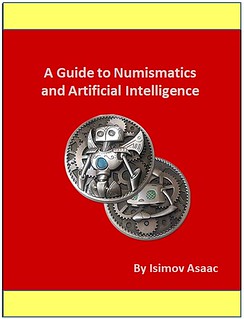
About UsThe Numismatic Bibliomania Society is a non-profit association devoted to the study and enjoyment of numismatic literature. For more information please see our web site at coinbooks.org SubscriptionsThose wishing to become new E-Sylum subscribers (or wishing to Unsubscribe) can go to the following web page link MembershipThere is a membership application available on the web site Membership Application To join, print the application and return it with your check to the address printed on the application. Print/Digital membership is $40 to addresses in the U.S., and $60 elsewhere. A digital-only membership is available for $25. For those without web access, write to: Charles Heck, Treasurer AsylumFor Asylum mailing address changes and other membership questions, contact Terry at this email address: terrywhite5475@yahoo.com SubmissionsTo submit items for publication in The E-Sylum, write to the Editor at this address: whomren@gmail.com
BUY THE BOOK BEFORE THE COIN |
- WAYNE'S WORDS: THE E-SYLUM APRIL 10, 2019
- MEXICAN NUMISMATIC LITERATURE CONFERENCE
- NEW BOOK: IMPERIAL COINS OF ANNAM
- BOOK REVIEW: CURIOUS CURRENCY
- F.C.C. BOYD COLONIAL PAPER MONEY INVENTORY
- VIDEO: PAUL WHITNAH SHARES STORIES
- WARNER CLYDE HUBBARD
- NOTES FROM E-SYLUM READERS: APRIL 7, 2019
- QUERY: LINDBERGH CHINESE AVIATION MEDAL
- VOCABULARY WORD: BRUMMAGEM
- VOCABULARY TERMS: TALISMAN
- CHARLES ELLIOT MAKEPEACE (1855-1931)
- HARVEY STACK'S NUMISMATIC FAMILY, PARTS 40-41
- 2019 EAC EDUCATIONAL PRESENTATIONS
- GAO STUDIES BENEFITS OF REPLACING DOLLAR BILL
- MORE ON THE POTENTIAL BEP MOVE
- BELL SALE NORTH AMERICA FRENCH COLONIES COINAGE
- HERITAGE SALE ANTI-SLAVERY MEDALS
- NUMISMAGRAM MEDAL SELECTIONS: APRIL 2019
- NUMISMATIC NUGGETS: APRIL 7, 2019
- WAYNE'S NUMISMATIC DIARY: APRIL 7, 2019
- NUMISMATICS AT THE NATIONAL MUSEUM IN KRAKOW
- SEAL OF KING JOSIAH COURT OFFICIAL FOUND
- DETECTORIST FINDS AUREUS OF EMPEROR ALLECTUS
- JERSEY COIN HOARD FINDERS AWAITING REWARD
- SONAR ENGINEERS COLLECT CENTRAL AMERICA SHARE
- CENTRAL GLASS COMPANY COIN GLASS
- HIGHLANDERS MUSEUM DISPLAYS VICTORIA CROSSES
- BANKSY’S CHIROGRAPH SYSTEM
- LOOSE CHANGE: APRIL 7, 2019
- MINT WEB SITE OUTAGE LEADS TO FREAK DEATH
- FEATURED WEB SITE: BRITISH BANKNOTE PICTURE LIBRARY
Click here to access the complete archive
To comment or submit articles, reply to whomren@gmail.com
Content presented in The E-Sylum is not necessarily researched or independently fact-checked, and views expressed do not necessarily represent those of the Numismatic Bibliomania Society.
WAYNE'S WORDS: THE E-SYLUM APRIL 10, 2019
 This week we open with a numismatic literature conference, one new book, a review, updates from the Newman Numismatic Portal, and an update on a centenarian Mexican numismatist.
This week we open with a numismatic literature conference, one new book, a review, updates from the Newman Numismatic Portal, and an update on a centenarian Mexican numismatist.
Other topics this week include Lindbergh's Chinese Aviation medal, a new study on replacement of the dollar bill, information on the BEP's potential move, North American French colonies coinage, anti-slavery medals, numismatics at the National Museum in Krakow, Poland, great coin finds, the ANA National Money Show, coin glass, and British banknotes.
To learn more about the Sociedad Numismática de Monterrey, Imperial coins of Vietnam, primitive money, C. E. Makepeace, Clyde Hubbard, Jessie Zhang, Jeff Shevlin, the Numismatourist, talismans, the Icarus Flight medal, an aureus of the Roman Emperor Allectus, Bands of Wickedness, Dumbell's Banking Company and Banksy's chirograph system, read on. Have a great week, everyone!
Wayne Homren
Editor, The E-Sylum
MEXICAN NUMISMATIC LITERATURE CONFERENCE
A recent conference related to Mexican Numismatic Literature highlighted NBS and The E-Sylum. Many thanks to Adrián González-Salinas of Monterrey, N.L. México for this report, his presentation and recruiting of new subscribers. -Editor
Last Tuesday (April 2nd) I presented to the Sociedad Numismática de Monterrey (Monterrey's Numismatic Society @ Mexico) a conference related to Mexican Numismatic Literature in which I talked about the numismatic Mexican books by category including two slides on the Numismatic Bibliomania Society.



Also, I asked to our SNMty's members who was interested to be subscribed to The E-Sylum. Next day, I did receive 15 requests of SNMty's members!
Thanks for the publicity! I added everyone to our mailing list. Welcome! -Editor
NEW BOOK: IMPERIAL COINS OF ANNAM
The Asian Numismatic Society has announced a monograph on the Imperial coins of Annam (the name of Vietnam prior to 1945). -Editor
JUST PUBLISHED
All Gold and Silver Coins from 1883 to 1945
Complete Catalogue, 700 color illustrations
Auctions references, rarity rating
The indispensable continuation of the Schroeder catalogue
29 € + port / postage (France : 7 €, Europe : 3 €, America Asia : 4 €)
For more information, or to order, see:
10 - Série "Monnaies d'Asie"
(https://sites.google.com/site/societedenumismatiqueasiatique/-9---serie-monnaies-d-asie)




For more information I reached out to our resident Vietnam expert, Howard Daniel. He gave me a capsule review and pointed me the publisher, where I found the sample pages above. Thanks! -Editor
Howard writes:
I have already bought the book and it is sitting on my desk at this moment. The title is Monnaie Imperiales d,Annam by Professor Francois Joyaux and the ISBN is 978-2-906602-49-6. The author is a well-respected researcher in France. It does not by any means show all of the gold and silver since Schroeder was published, and there are replicas in it. But it does have some interesting new information and images for me. I would recommend it to an advanced collector but not to a novice. It is published by Editions Victor Gadoury in Monaco. I ordered the book from them. With postage, the total cost came to 54 Euros.
To order from Editions Victor Gadoury, see: https://www.gadoury.com/en/books/monnaies-imperiales-d-annam
BOOK REVIEW: CURIOUS CURRENCY
Ken Bressett penned this review of Bob Leonard's recently updated book Curious Currency. -Editor
Ken Bressett, Editor Emeritus of the Guide Book of United States Coins, shares his thoughts on “odd and curious” (primitive) money, and on Curious Currency: The Story of Money From the Stone Age to the Internet Age, Robert Leonard’s newly updated book on the subject.
 The use of money today is so ubiquitous that we seldom give thought to why it functions the way it does, how it came to be, or what we would do without it. People are paid for the work they do, or for their creative efforts or skills, and they spend that recompense for things they desire that have been provided to them by others. The bridge between effort, compensation, and reward is what is known as “money.” It is the necessary medium that keeps commerce functioning in an orderly manner without constantly negotiating the value of services versus products or payments.
The use of money today is so ubiquitous that we seldom give thought to why it functions the way it does, how it came to be, or what we would do without it. People are paid for the work they do, or for their creative efforts or skills, and they spend that recompense for things they desire that have been provided to them by others. The bridge between effort, compensation, and reward is what is known as “money.” It is the necessary medium that keeps commerce functioning in an orderly manner without constantly negotiating the value of services versus products or payments.
It often comes as a surprise when people learn that trade items, coins, and diverse forms of money have been used for thousands of years. An even greater revelation is that barter and trade must have played a crucial part in the early beginnings of civilized contact between prehistoric clans.
The desire to exchange surplus items for different things that were needed was the driving force in establishing customs and rules about how various items should be valued and how interchanges should be carried out. The ultimate solutions became what are now inclusively known as “money.” The long road to the variety of monies used today was not a straight path. Hundreds of different items have been used to accommodate the diverse needs of everyday commerce and trade by different societies throughout the years. Some of the items that were used defy credulity. Others have stood the test of time.
In its most succinct form, “money” can be anything that is acceptable to both parties in facilitating an exchange of goods or services between them. In actual use, anything and just about everything has been used as this bridge. Over the years most societies have agreed that precious metals—mainly gold, silver, and copper—are the most convenient and widely acceptable storehouses of value and thus the ideal medium of exchange for all goods and services. Even these, however, have their shortcomings. There simply is not a sufficient supply of these precious metals to serve the economic needs of the world.
Throughout the years specialized needs of various societies have been met by sanctioning unique forms of exchange. Some of these defy logic by today’s standards, but are probably no more implausible than our use of electronic transfers or plastic credit cards would seem to people even one hundred years ago. The scope and variety of strange monies of the past is further complicated by a general misunderstanding of the use of these objects as trade items, ornaments of personal wealth or status, barter goods, coins, tokens, and promissory payments.
In Curious Currency, with a fresh approach to understanding the nature of money in all its various forms, author and researcher Robert Leonard presents an entertaining overview of what can only be called a most unusual and bizarre assemblage of items that were once used to facilitate trade. While it is difficult to comprehend how stones could ever be used as money, they most certainly were and Mr. Leonard tells their story at length. Stone money is only one of the many unusual items he describes and shows.
The story of money, in a very real sense, is the story of world history. Not in the stuffy schoolbook sense, but when stories about money are tied to world events they speak of actual actions. Money, in the form of coins, contracts, odd objects made of shells, beads, cloth, or stone, was part of the wars, famines, growth, and glory days of many nations. A study of what has served as money, past and present, can help everyone better understand its nature and use through prosperous and troubled times, and how it functions today.
When some Neolithic man fashioned the first useful stone or flint tools they must have quickly become coveted trade items that could be exchanged for the surplus food gathered by other clansmen. Little could these early people realize that this convention was to be the beginning of commercial transactions that would impact the entire world and nearly every facet of life thereafter. Such primitive exchanges were scarcely much different than the bartering that went on in America when the Forty Niners left their homes and traveled to California in search of a golden dust that they could trade for whatever luxuries they wanted.
Only a few hundred years ago, in the days when much of America was still a British colony, tobacco, lumber, furs, musket balls, and beads took the place of scarce silver and gold coins. At that time barter with farm products, known as “country pay,” served our ancestors well for many years. It is, in fact, still used to some extent today in rural communities.
Knowledge of how the various forms of money served economic needs in the past may hold clues as to how money should be regarded today, and how people can cope with the universal concerns about inflation, credit problems, management of wealth, and governance. Mr. Leonard’s provocative study of how hundreds of societies have adapted to using nonstandard items to meet their needs can only lead to the conclusion that most forms of money and wealth are based on faith, and in the end may all be ephemeral.
 Author Robert D. Leonard Jr. autographing books at the ANA
World’s Fair of Money in Denver, August 3, 2017.
Author Robert D. Leonard Jr. autographing books at the ANA
World’s Fair of Money in Denver, August 3, 2017.
Curious Currency: The Story of Money from the Stone Age to the Internet Age, 2nd edition
By Robert D. Leonard Jr.; foreword by Kenneth Bressett
ISBN 0794846394. Hardcover, 6 x 9 inches, 160 pages, full color, retail $16.95 U.S.
https://www.whitman.com/store/Inventory
/Detail/Curious-Currency-2nd-Edition+0794846394

F.C.C. BOYD COLONIAL PAPER MONEY INVENTORY
The latest addition to the Newman Numismatic Portal is the F.C.C. Boyd Colonial Paper Money Inventory. Project Coordinator Len Augsburger provided the following report. Thanks. -Editor
 Recently scanned by Newman Portal is the inventory of colonial paper money from the F.C.C. Boyd estate. Michael Hodder wrote of the Boyd collection in the Ford III (Stack’s, 5/2004) catalog: “Despite not having many reference texts to assist him, he built the basis for what may be the most comprehensive private collection of Colonial American paper currency ever formed.” Eric P. Newman was able to personally inspect portions of the collection as they were sent to him for review, c. 1963, by New Netherlands (Charles Wormser and John J. Ford, Jr.), who handled the Boyd estate.
Recently scanned by Newman Portal is the inventory of colonial paper money from the F.C.C. Boyd estate. Michael Hodder wrote of the Boyd collection in the Ford III (Stack’s, 5/2004) catalog: “Despite not having many reference texts to assist him, he built the basis for what may be the most comprehensive private collection of Colonial American paper currency ever formed.” Eric P. Newman was able to personally inspect portions of the collection as they were sent to him for review, c. 1963, by New Netherlands (Charles Wormser and John J. Ford, Jr.), who handled the Boyd estate.
The file includes correspondence related to possible acquisitions by Newman. This appears to have not occurred, and the Ford sale catalogs indicate that many pieces were acquired by Ford from the Boyd estate. Numerous examples from the Boyd/Ford collection were used for plate images in Newman’s Early Paper Money of America (first edition, 1967), and these likely trace to this period in the early-1960s when Newman had access to the material. The inventory includes notes by Walter Breen, who would have been enlisted by New Netherlands for the task.
Link to the F.C.C. Boyd Colonial paper money inventory:
https://archive.org/details/boydfccinventory1963epnresearch
Link to John J. Ford, Jr., sale catalogs:
https://archive.org/details/newmannumismatic?and%5B%5D=%22john+j.+ford%2C+jr.+collection%22&sin=
VIDEO: PAUL WHITNAH SHARES STORIES
Here's a video produced by David Lisot at the 2008 EAC convention. -Editor
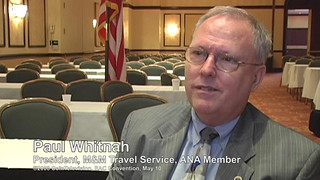 Another great numismatic video has surfaced that will be posted on the Newman Numismatic Portal. In 2008 the Early American Coppers Convention was held in Irving, Texas. David Lisot was there to document the convention and videoed an interview with longtime America Numismatic Association volunteer and friend Paul Whitnah of M&M Travel Service. Paul was in charge of the Message Center for the ANA Conventions as a volunteer and agreed to share his memories. The interview was not edited until David agreed to post all his previous videos on the Newman Numismatic Portal. Finally the story of this great numismatic personality, Paul Whitnah, can be told.
Another great numismatic video has surfaced that will be posted on the Newman Numismatic Portal. In 2008 the Early American Coppers Convention was held in Irving, Texas. David Lisot was there to document the convention and videoed an interview with longtime America Numismatic Association volunteer and friend Paul Whitnah of M&M Travel Service. Paul was in charge of the Message Center for the ANA Conventions as a volunteer and agreed to share his memories. The interview was not edited until David agreed to post all his previous videos on the Newman Numismatic Portal. Finally the story of this great numismatic personality, Paul Whitnah, can be told.
The entire interview is available on the Newman Numismatic Portal at https://nnp.wustl.edu/library/multimediadetail/522852 .
Paul Whitnah Shares Stories of Famous Coin Collectors, May 10, 2008. VIDEO: 21:22.
Paul Whitnah, President, M&M Travel Service, Arlington, TX, David Lisot, Interviewer, CoinTelevision.com.
Paul Whitnah has known some of the greatest coin personalities in his lifetime including Eva Adams, Q. David Bowers, Walter Breen, Ken Bressett, Mary Brooks, Grover Criswell, Virginia Culver, John Ford, Clyde Hubbard, John Jay Pittman, Ed Rochette, P.B. Trotter, Adna Wilde, and many more. In this interview Paul shares his memories and talks about the great numismatists he has known.
An excerpt of the video is available for viewing on the Coin Television YouTube Channel at: https://youtu.be/XqUtpZwnxM8
WARNER CLYDE HUBBARD
Adrián González-Salinas submitted this response to Pete Smith's question about centenarian numismatists. -Editor
I enjoyed the listing of the oldest numismatists where Mr. W. Clyde Hubbard appears. Mr. Hubbard is still living in Cuernavaca, Morelos, Mexico. He was born on 26 February 1916 (103 years ago!). In fact, a medal was struck to celebrate his 100th anniversary. I've attached the images of this medal.

Mexicanus Numisma Rex: King of Mexican Numismatics! -Editor
Pete Smith writes:
Cool! Now I've got to get one of those medals.
Finding one won't be easy, though. Be on the lookout! -Editor
Adrián adds:
The engraver of the Hubbard's medal was Lorenzo Rafael (his initials appears at left of Hubbard's neck). I know that it was a private issue then not available for sale. In fact, I don't have one of them.
The legend and inscription of the medal's reverse are: "Proclamado en la C(iuda)d de Cuernavaca el 26 de Febrero de 2016 | Centenario del S(eño)r D(o)n Warner Clyde Hubbard" ans its translation: "Proclaimed in the City of Cuernavaca on February 26, 2016 | Centenary of Mr. Warner Clyde Hubbard".
To read the earlier E-Sylum article, see:
NOTES FROM E-SYLUM READERS: MARCH 31, 2019 : Query: Centenarian Numismatists
(https://www.coinbooks.org/v22/esylum_v22n13a15.html)

NOTES FROM E-SYLUM READERS: APRIL 7, 2019
April Fool 2018
Pete Smith writes:
The April 1 issue of The E-Sylum is always amusing and a challenge to pick the "April Fools" items. What happens when the issue is not published on April 1? Does the foolishness extend to the issue published on the closest date?
I loved the article about Isaac Asimov's new book on numismatics and AI, a neat trick,considering that Asimov died 17 years ago. A good April Fool's article.
Chris Fuccione writes:
When I saw the article on Isimov Asaac's new book NUMISMATICS AND AI I had to laugh. The good doctor always enjoyed wordplay (and dirty limericks). I suspect he would have enjoyed this.
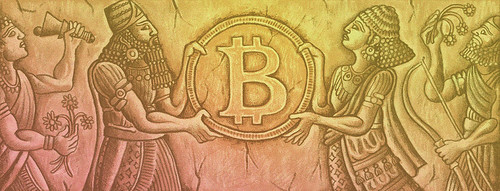
Thanks, everyone. Some people weren't sure about the bitcoin article, but it was real despite the amusingly cool graphic. Another one people speculated about was the stolen coin article, but I reached back to Doug Davis of the Numismatic Crime Information Center who confirmed to me that "The coins were stolen from a collector. No joke."
The only intentional foolish article was the Numismatics and Artificial Intelligence piece. David Pickup submitted the text and I came up with the illustration. For a belated April Fool's article, see Ken Barr's piece at the end of this issue. Thanks, everyone. -Editor
To read the earlier E-Sylum articles, see:
NEW BOOK: NUMISMATICS AND AI
(https://www.coinbooks.org/v22/esylum_v22n13a05.html)
IS CRYPTOCURRENCY REALLY A NEW IDEA?
(https://www.coinbooks.org/v22/esylum_v22n13a30.html)
1794 DOLLAR, 1894-S DIME REPORTED STOLEN
(https://www.coinbooks.org/v22/esylum_v22n13a24.html)
1771 Pugachev Rouble Fake
A couple weeks ago web site visitor Lance Schweiter asked about the genuineness of a 1771 Pugachev Sestroretsk rouble, and I got opinions from collectors Steve Bishop and Eric Schena. Here's a follow-up. -Editor

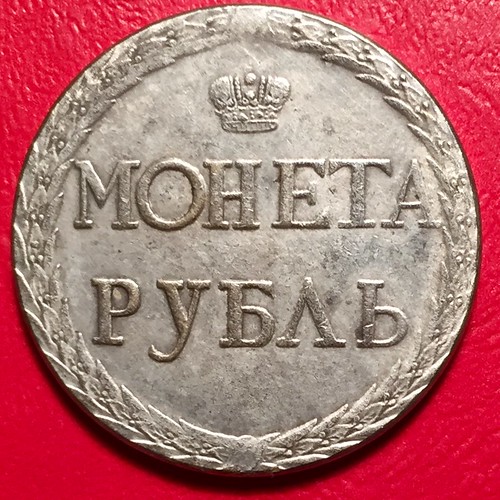
Lance writes:
I had it tested with a spectrometer. The coin is a copy. It's made of copper-plated manganese and a Chinese import.
Thanks for the update. See the earlier article for the full discussion. -Editor
To read the earlier E-Sylum article, see:
QUERY: 1771 PUGACHEV ROUBLE
(https://www.coinbooks.org/v22/esylum_v22n12a26.html)
Another Wreath-Wreath Medal Mule
In February 2019 Jonathan Brecher issued a challenge to our readers to identify some unusual U.S. Mint medals featuring wreaths as part of the design. Some of the medals were rare "mules" - pieces struck with dies not originally intended or often seen to be together. Two were mules of two wreath-reverse designs. Now he has a new find for us. Click the images to find high-resolution images in our Flickr library. -Editor
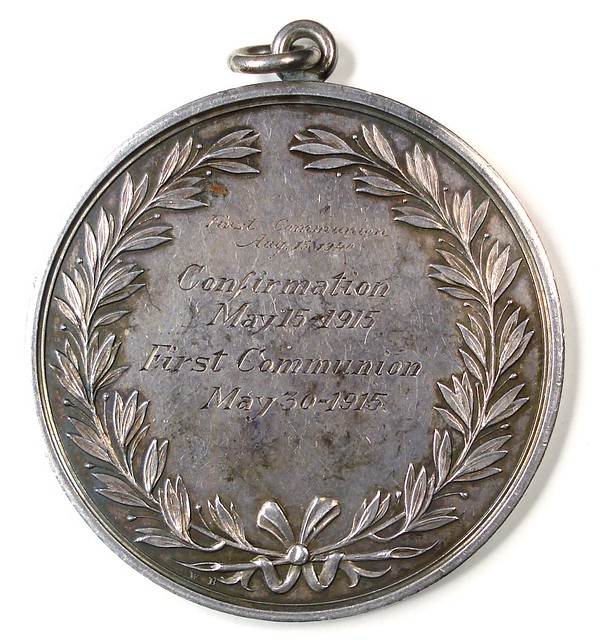

Jonathan writes:
Unlike the previous two, I haven't identified this one. Also unlike the previous two, this one is signed, with a small W B at 7:00 on the laurel (?) side. William Barber could make sense, except that I can't match up either side with any medal that he produced. But I can't find a good candidate for a different W B medallist either.
This appears to be a dual-use medal, passed from father to daughter. The central engraving on either side reads "Confirmation / May 15 - 1915 / First Communion / May 30 - 1915" and (I think) "John Keating Jr / Church of St. Peter / and Paul / Cumberland Md.". Smaller text was apparently added later: "First Communion Aug 15, 1940" and Jane A. Keating / St. Catherines Church / Wayne Pa.". The text on the name side has been partially effaced.
There was a John Keating Jr born August 6, 1906, in Cumberland, Maryland, who later moved to Wayne, PA. I don't see anything numismatically interesting about him or his family.
Silver, 51.2 mm. The quality is quite good, and has the stepped rim that Dan Carr noticed on the others. This could be a US Mint medal... but that's just speculation without something to match it up against.
Thanks. Another unusual piece. Can anyone help with this item? -Editor
To read the earlier E-Sylum articles, see:
EXPERT-LEVEL U.S. MEDALS CHALLENGE
(https://www.coinbooks.org/v22/esylum_v22n07a16.html)
EXPERT-LEVEL U.S. MEDALS CHALLENGE RESULTS
(https://www.coinbooks.org/v22/esylum_v22n08a12.html)
QUERY: LINDBERGH CHINESE AVIATION MEDAL
Web site visitor Eric R. Caubarreaux writes:
Any idea what the name of this medal is? The medal was awarded to Charles Lindbergh in September 1931 by Chiang Kai Shek.


Very interesting. Would anyone have more information on this medal, or its whereabouts today? The article notes that it was once placed on display at the Jefferson Memorial. Thanks. -Editor
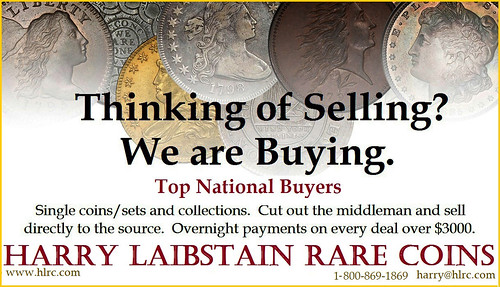
VOCABULARY WORD: BRUMMAGEM
Gosia Fort writes:
Can coins influence the language? Yes, they can. According to the Merriam-Webster Dictionary, counterfeit coins lie at the heart of the word-of-the-day for April 5th, which is “brummagem” meaning not genuine, spurious; also cheaply showy, tawdry. It first appeared as an alteration of Birmingham, the name of the English city notorious for the counterfeit coins and quickly became associated with things forged and not authentic.
Never heard of that word! Interesting. I'll start working it into conversation just for grins. Here's the full definition. Thanks! -Editor

Definition
: not genuine : spurious; also : cheaply showy : tawdry
Did You Know?
Brummagem first appeared in the 17th century as an alteration of Birmingham, the name of a city in England. At that time Birmingham was notorious for the counterfeit coins made there, and the word brummagem quickly became associated with things forged or inauthentic. By the 19th century, Birmingham had become a chief manufacturer of cheap trinkets and gilt jewelry, and again the word brummagem followed suit—it came to describe that which is showy on the outside but essentially of low quality. Perhaps the term was something of an annoyance to the people of Birmingham way back when, but nowadays when brummagem is used (which isn't often) it's usually without any conscious reference to the British city.
Examples
The members of the bachelorette party stumbled out of the limousine with the bride wearing a brummagem tiara and sash.
To read the complete article, see:
brummagem
(https://www.merriam-webster.com/word-of-the-day/brummagem-2019-04-05)
VOCABULARY TERMS: TALISMAN
Dick Johnson submitted this entry from his Encyclopedia of Coin and Medal Terminology. Thanks. -Editor
Talisman. A medallic object of superstitious design intended to be carried to ward off evil. All good luck pieces are talismans (yes, the plural of talisman is talismans). They are the strongest of the superstitious powers in comparison with amulets and charms. As such they are often more grotesque, more symbolic and more widely used. They appeal to superstitious people and have for centuries. Their history extends from earliest man, who tied a tiger claw around his neck for good luck, to present-day advocates.
Talismans were purposely designed to be superstitious, often with overtones of magic, myth, folklore or witchcraft. The more powerful its design, the more power it was supposed to have to ward off evil or have other extraordinary effects for the owner. A talisman was intended to be worn around the neck, or in smaller size elsewhere on the body. For those that were not worn they would be placed above the entranceway to a house or building.
Talismanic medals were often of unusual shape, as the shape is a part of its symbolism. Usually engraved by hand, they were made one at a time and never in quantity (until, perhaps, in modern time, when small round good luck medals were made in quantity as pocket pieces).
Talismanic symbols. It seems in each culture a symbol derives for good luck. The Chinese dragon, the Roman cornucopia, the Assyrian scarab, the Hebrew chai, the Greek fish, the Irish four-leaf clover, the Persian simurgh, the American horseshoe. These have appeared on good luck medals and talismans. In 1976 the Franklin Mint issued twelve of these in a medallic set of bronze and silver good luck medals.
The five-pointed star (pentacle) and six-pointed star (hexagram) are also popular on talismanic pieces, as are a host of arcane symbols.
Wearing or carrying talismans, like consulting a horoscope, obviously, has no way of influencing reality. It is a superstitious act for diversion purposes only; as such talismans are accepted as being anti-scientific although somewhat entertaining.
Looking for the meaning of a numismatic word, or the description of a term? Try the Newman Numismatic Portal's Numismatic Dictionary at: https://nnp.wustl.edu/library/dictionary
Or if you would like a printed copy of the complete Encyclopedia, it is available. There are 1,854 terms, on 678 pages, in The Encyclopedia of Coin and Medal Technology. Even running two a week would require more than 19 years to publish them all. If you would like an advance draft of this vital reference work it may be obtained from the author for your check of $50 sent postpaid. Dick Johnson, 139 Thompson Drive, Torrington, CT 06790.
CHARLES ELLIOT MAKEPEACE (1855-1931)
 Charles Elliot Makepeace (1855-1931), was born on December 11, 1855, in the town of Pamelia, Jefferson County, New York, son of Elliot Makepeace, an affluent farmer, and Angeline P. Plumb Makepeace. In 1804, his paternal grandfather Thomas Makepeace was one of the first settlers in Pamelia. Pamelia Four Corners is a small post village in the northeastern part of Pamelia, nine miles from Watertown, 181 from Albany, and 333 from New York City.
Charles Elliot Makepeace (1855-1931), was born on December 11, 1855, in the town of Pamelia, Jefferson County, New York, son of Elliot Makepeace, an affluent farmer, and Angeline P. Plumb Makepeace. In 1804, his paternal grandfather Thomas Makepeace was one of the first settlers in Pamelia. Pamelia Four Corners is a small post village in the northeastern part of Pamelia, nine miles from Watertown, 181 from Albany, and 333 from New York City.
Makepeace was born into an illustrious colonial family who owned a homestead and farm in Pamelia, Jefferson County, New York. After graduation he became teacher in town and used his ingenuity to develop mechanical and electrical means to improve production of lumbering, feed grain, and washing machines. In the late 1870's he became a coin collector and dealer advertising in Numisma buying and selling old U. S. silver and copper coins and issued his catalogue.
Makepeace grew up on the family farm and became a teacher in the town of Pamelia.
Makepeace was for many years engaged in the agricultural implement business.
He was junior member of the firm of Dean & Makepeace, a flour and feed supplier, Watertown, New York, for many years, and was one of the first in the United States to use electricity in the grinding of feed.
In 1890, Pamelia Four Corners had a Limburger cheese factory owned by C. E. Makepeace, Ward M. Nichols, and William Mills, on road 21, which manufactured about 35,000 pounds annually.
He died on January 30, 1931.
To read the complete article, see:
(https://sites.google.com/a/numismaticmall.com/www/numismaticmall-com/makepeace-charles-elliot)
The entire inventory of the Lupia Numismatic Library is for sale. Individual items will be available before the remaining archives are broken up into parcels sold at philatelic auctions in the U. S. and Hong Kong. Check NumismaticMall.com frequently as dozens of new items with estimates will be posted daily until everything is sold.
All inquiries will be given prompt and courteous attention. Write to: john@numismaticmall.com .

HARVEY STACK'S NUMISMATIC FAMILY, PARTS 40-41
Harvey Stack's blog series focuses on living in a numismatic family. Here are parts 40 & 41. Thanks, Harvey. -Editor
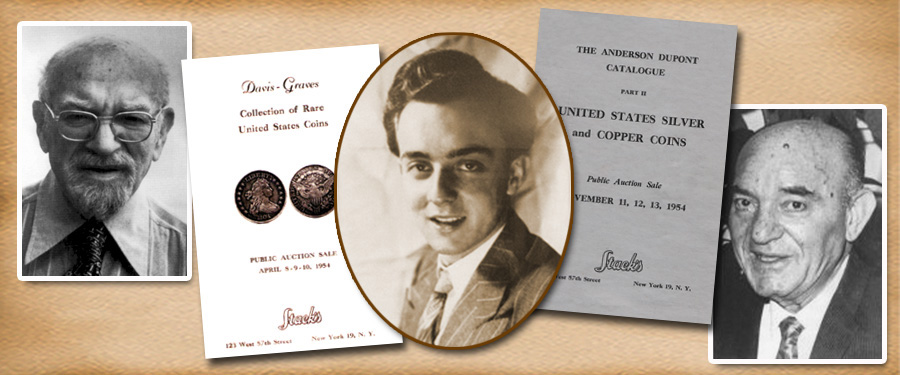
As 1966 opened, the coin hobby continued to be active and much time was dedicated day and night to our numismatic business at Stack's. We had a series of important auctions, we were very active in our retail sales (both over the counter and from mail order), we attended many shows and conventions, and we continued to build the J.K. Lilly Collection. Stack's was also dedicated to trying to find ways to understand the requirements of the OGSO for acquiring licenses to import gold into the United States. This non-stop engagement demonstrates why 1966 was a year that I will never forget.
In 1966 many collectors joined the hobby, with the American Numismatic Association gaining many new members. Many shows were conducted nationwide to bring dealers and collectors together. New information became available and those who had already published references, expanded on them. Starting in the 1930s, the catalog listing coins by date and price was the Standard Catalog of U.S. Coins by Wayte Raymond, followed by the Guide Book of United States Coins by R.S. Yeoman (the Red Book). Numismatic News began in 1952 followed by Coin World in 1963.
The explosion of available information, with some published weekly, kept the coin market informed, taught about the hobby, and encouraged many to start collecting or expand their interest. There was current information available, whether you were near a big city or out in the country, helping collectors to learn about coins and pricing – essential to the expansion of the hobby that was taking place during this time. Even the hype surrounding the Mint's discontinuation of producing coins in silver brought many people to the hobby. By 1966 more collectors were entering the field, visiting coin shops, attending coin shows and conventions; the market grew and prices rose.
This price rise was noted by those who had collections or had inherited cabinets and this motivated some to put their coins on the market, which meant that Stack's was able to offer some important auctions in 1966. To start the year we offered the Dr. Conroy Bolt Collection (built years earlier by George Walton, and Stack's), which offered gold coins issued by southern states, starting with the Bechtler pieces and including complete runs of gold coins from the Dahlonega, Charlotte and New Orleans mints. Dr. Bolt also had an extensive collection of U.S. silver and copper issues. We also auctioned the Lee S. Miller Collection of copper coins, the Wilson Rise coins, the Andrew Watson Collection and the fabulous, high quality collection formed by Maurice Bauman. The last sale included a featured collection of half dollars that my cousin, Norman, and I had helped Mr. Bauman build. As in so many cases we had the opportunity to both build and later sell a collection.
For some 16 years Stack’s had been dedicated to building a world class gold coin collection for Mr. J.K. Lilly of Eli Lilly & Co. As previously mentioned he would visit Stack’s twice a year in the spring and fall. He would advise us how he wished to proceed, we would endeavor to find the coins he desired and get them together for his approval. He would review the purchases, usually accept them and then the coins would be personally delivered to him in Indianapolis, usually by me. The coins would then be put in what he considered his Hobby House, along with his many other collections.
However, in September of 1965 we got a call from Mr. Lilly’s secretary that he was ill and would not be going to Palm Beach that year. Mr. Lilly requested that we hold any coins for later delivery. We kept in touch with his secretary who kept us informed of his condition. Sometime in April 1966 he had her call to ask if I could make a very brief visit to him within the next two weeks. Of course I made a date and went to Indianapolis with the coins he wished to add to his collection.
I arrived in Indianapolis and promptly at 8:30 was picked up and taken to Mr. Lilly. On this visit I was taken to his home in town called "Oldsfield." It was a beautiful estate , near the cultural center of town. It had about 40 acres of magnificent gardens, mostly roses in full bloom, and there was a lovely home made from large granite natural rock, with incredible views of the gardens.
I was welcomed at the door by the houseman, who told me that Mr. Lilly was upstairs in his study next to his bedroom. There I found Mr. Lilly, sitting at his desk in the center of the room. He got up to greet me and asked me to sit down. Remembering the instructions I received I showed him the box of coins I brought, he looked at them, and said, "What wonderful things you have assembled for me. I am delighted and thank you." He insisted in making out a check, even with his shaking hands and giving it to me. He expressed his gratitude for all our family had done to build his collection. I was embarrassed, but pleased, by his warm remarks and we shook hands. The time to go arrived quickly and I bid him good health and said goodbye. Two weeks later, to the day, I received a call from Mr. Lilly’s office that he had passed away the night before. I asked about the services, for I did want to attend. After all I considered him a friend and had worked with him for 16 years. However, the family decided to have a private ceremony.
This was a very close and important numismatic relationship for me, especially since I was present when he began and was with him when he acquired his last coins. His desire for privacy meant we never revealed his name to anyone, and only to our immediate staff did we ever mention that it was just one collector. Everyone thought we had maybe five different clients who specialized in gold coins, but no one would think it was for one special collector.
Once the family agreed that we could talk about the collection and the work we did with Mr. Lilly we took out an ad that said:
"The secret isn’t secret any longer. We, for the last 16 years built a gold coin collection that is surely ‘world class’ and is the finest collection of its type built by a single collector with a single agent, Stack’s.
“This world wide collection of gold coins, including a virtually complete collection of United States gold coins is one of the most extensive ever built, as it contains over 6,100 different gold coins of the world
“Further information will be announced in the future.”
To read the complete articles, see:
Harvey Stack Remembers: Growing Up in a Numismatic Family, Part 40
(https://www.stacksbowers.com/News/Pages/Blogs.aspx?ArticleID=3322)
Harvey Stack Remembers: Growing Up in a Numismatic Family, Part 41
(https://www.stacksbowers.com/News/Pages/Blogs.aspx?ArticleID=3334)
To read the earlier E-Sylum article, see:
HARVEY STACK'S NUMISMATIC FAMILY, PART 39
(https://www.coinbooks.org/v22/esylum_v22n10a16.html)
2019 EAC EDUCATIONAL PRESENTATIONS
The upcoming convention of the Early American Coppers group will feature a number of great educational presentations. Here's the program, courtesy of EAC President Bill Eckberg. Thanks! All presentations will be at the Dayton Convention Center, 22 E. Fifth St., Dayton, OH 45402. -Editor
FRIDAY MAY 3, 2019
10:00 AM - 4:00 PM Educational Presentations Rooms 202-203
10 AM Publications Committee Presentation: Lou Alfonso, Bill Eckberg, Harry Salyards
EAC is establishing a committee to promote book publication by members. This will be the initial presentation of the committee
11 AM Connections: Black Pepper, the Mountain That Eats Men, and John Reich: Bradley Karoleff
1 PM Half-a-Century Strong: A Little EAC History: Mark Borckardt
Mark is the EAC historian and will be reporting on the progress of the history of EAC that he is writing
2 PM Recent 1795 Half Cent Discoveries: Ed Fuhrman
Ed will be presenting information on some interesting 1795 half cents that he has discovered, one of which has received substantial coverage in the general numismatic press.
3 PM Dr. William H. Sheldon, Ted Naftzger, and the Large Cent Thefts: Dr. John M. Kleeberg (Via YouTube, presented with permission of ANS and Dr. Kleeberg). Jim Neiswinter
This will be a video presentation of an ANS lecture that John gave recently.
3:00 PM - 4:00 ACC&E club and workshop, a Facebook workshop for Early American coins, Greg Hannigan Table 59
This is a presentation on a new Facebook group that Greg has established to promote the collecting and study of Americana, Coins, Currency & Exonumia.
8:00 PM – ??? EAC and ANS remember Del Bland
This will be an informal reception to honor a recently deceased researcher of great importance to early copper.
SATURDAY MAY 4, 2019
10:00 AM - 4:00 PM Educational Presentations – Rooms 202-203
10 AM The Thrill of the Hunt: John Wright
John has been a giant of early copper collecting for many years and will talk on collecting.
11 AM Half Cent Type Collecting: Bill Eckberg
What constitutes a proper type set of half cents?
1 PM In the Trenches: Fighting Against Counterfeits: Beth Deisher
Beth has been one of the leaders in the fight agains counterfeit collector coins. She will speak on the progress.
2 PM EAC 101: What Every New EAC Member Needs to Know: Chuck Heck, David Huang
Important information for collectors new to early copper or seasoned collectors who know they still have a lot to learn.
3 PM Don’t Be Shy: The Garvin Fund Offers Money Grants: Lou Alfonso
How to get EAC to support your attendance at numismatic events.
For more information, see:
https://eacs.org/

GAO STUDIES BENEFITS OF REPLACING DOLLAR BILL
The U.S. Government Accountability Office (GAO) issued a report last month on the financial benefit of switching to a $1 coin. The results were not what one might expect. Thanks to Pabitra Saha for passing this along. -Editor
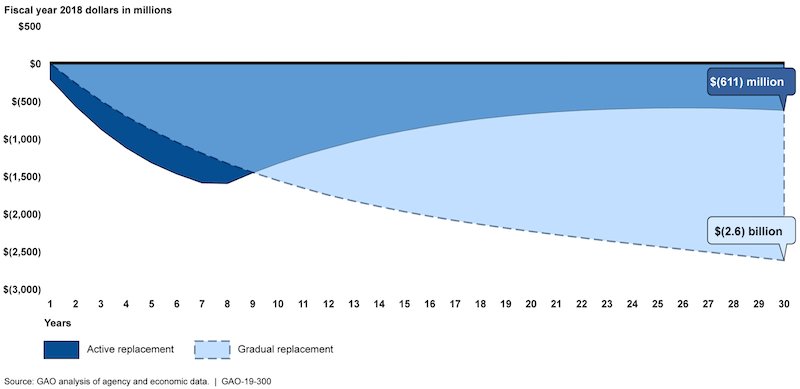
What GAO Found
GAO’s analysis found that replacing the $1 note with a $1 coin would likely result
in a net loss to the government over 30 years. GAO found the government would
incur a loss of about $611 million if notes were actively replaced and about $2.6
billion if $1 notes were replaced gradually (see figure). These simulations
represent the first time GAO has found that replacing the $1 note with a $1 coin
would result in a net loss to the government rather than a net benefit. GAO’s
estimates are based on current data and economic projections, which have
changed over time. For example, the lifespan of the $1 note has more than
doubled since a 2011 GAO analysis, from 3.3 years to 7.9 years, largely due to
changes in note processing technology. Stakeholders generally identified few
benefits from replacing $1 notes with $1 coins. Seven of 10 stakeholders GAO met
with said that replacing the $1 note with a $1 coin would result in additional
costs. For example, armored carriers told GAO that their transportation costs
would increase because coins weigh more than notes.
Why GAO Did This Study
The U.S. spent about $1.3 billion in
2017 to produce, process, and
circulate coins and paper notes for use
in the economy. Since 2006, both the
penny and nickel have cost more to
make than their face value. Other
countries have replaced notes with
coins of the same value to reduce
costs. Since 1990, GAO had estimated
replacing the $1 note with a $1 coin
would provide a benefit to the federal
government.
GAO was asked to examine the potential cost savings to the government from making changes to currency. This report (1) estimates the net benefit to the government, if any, of replacing the $1 note with a $1 coin and selected stakeholders’ views on this change; and (2) examines what is known about potential cost savings from suspending penny production and changing the metal composition of the nickel, and selected stakeholders’ views on these changes. GAO conducted economic simulations of continued use of $1 notes and replacing notes with $1 coins, examined cost data from the U.S. Mint, and interviewed officials from the Federal Reserve, U.S. Mint and Bureau of Engraving and Printing as well as 10 selected stakeholders representing industries that could potentially be affected by currency changes.
What GAO Recommends
Congress should consider taking steps
to authorize the Secretary of the
Treasury to adjust the metal content of
circulating coins.
It's a lengthy report, but interesting reading nonetheless. There is a response from U.S. Mint Director David Ryder included as an appendix. -Editor
To read the complete article, see:
Financial Benefit of
Switching to a $1 Coin
Is Unlikely, but
Changing Coin Metal
Content Could Result
in Cost Savings
(https://www.gao.gov/assets/700/697778.pdf)
Rich Bottles Jr. forwarded an article about the report, noting: "It seems that dollar bills are lasting longer as US consumers move more toward cashless purchases, thus eliminating any cost savings by switching solely to dollar coins." -Editor
 These simulations represent the first time GAO has found that replacing the $1 note with a $1 coin would result in a net loss to the government rather than a net benefit.
These simulations represent the first time GAO has found that replacing the $1 note with a $1 coin would result in a net loss to the government rather than a net benefit.
GAO said that while it has found in the past that use of a coin would save money, times have changed. The difference today is largely due to the longer life span of dollar bills that didn’t used to exist:
Due to this substantially longer note lifespan, fewer $1 notes need to be produced over a 30-year period, which reduces the cost of producing them and diminishes the relative advantage of the long coin life. In our 2011 simulations, a $1 coin was assumed to last about 10 times as long as a $1 note (34 years to 3.3 years); in our current simulations, the lifespan of the coin remains the same but is now only about 4.3 times as long as that of the note (34 years to 7.9 years). Meanwhile, the relative cost of producing coins and notes has remained about the same.
The Federal Reserve has improved its process of producing dollar bills which makes them last longer and also results in having to produce fewer of them which ultimately lowers costs.
To read the complete article, see:
Would Replacing the Dollar Bill with a Coin Save the Government Money?
(https://www.fedsmith.com/2019/03/30/replacing-dollar-bill-coin-save-government-money/)
MORE ON THE POTENTIAL BEP MOVE
More information is trickling out about the BEP's potential move out of Washington, D.C. Here's a report from a local radio station. -Editor
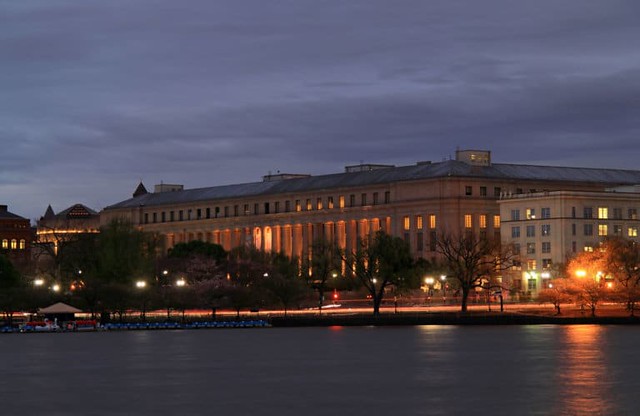
The U.S. Bureau of Engraving and Printing has been printing U.S. currency in the District for well over a century and is a popular destination for D.C. tourists, but it may move to Maryland.
The Bureau of Engraving and Printing is evaluating a 100-acre site on the U.S. Department of Agriculture’s Beltsville Agricultural Research Center in Prince George’s County as a potential location for a new production facility.
The new facility would house all operations for printing U.S. paper currency and other federal security products.
The Bureau of Engraving and Printing has partnered with the USDA and the U.S. Army Corps of Engineers to study the feasibility of the site.
There is no timeline for the bureau’s evaluation process, though it will include soliciting input from the public and government officials.
In addition to D.C., the engraving and printing bureau has a production facility in Fort Worth, Texas.
Its original D.C. headquarters and production facility, at 14th and B Street, SW, just off Independence Avenue, opened in 1880. The modern day operations remain located in two buildings.
One day my GPS system routed me through the Beltsville USDA site and I was amazed at the buccolic hidden stretch of farmland just minutes from the Capitol Beltway. There is certainly room there for a large facility, but it could mean a big loss to the landscape. -Editor
To read the complete article, see:
Popular tourist stop Bureau of Engraving and Printing may move to Maryland
(https://wtop.com/business-finance/2019/04/bureau-of-engraving-a-printing-a-top-tourist-stop-may-move-to-maryland/amp/)
To read the earlier E-Sylum article, see:
LOOSE CHANGE: MARCH 31, 2019 : BEP To Build New D.C. Facility
(https://www.coinbooks.org/v22/esylum_v22n13a32.html)

BELL SALE NORTH AMERICA FRENCH COLONIES COINAGE
Brian Bell forwarded the Introduction to lots 1-549 in the upcoming Geoffrey Bell Auctions sale #20. This section closes May 2, 2019. Thanks! This catalog will be an important reference work on the French Colonies coinage for North America. -Editor
 The French Colonies coinage for North America is something unusual in numismatics. It spans well over a
century, incorporates many distinct coinage types and metals, comprises regular struck coins, overstrikes and
countermarks, and has a wealth of varieties, with at least some types struck at each of the 29 French mints. Some were
produced in immense quantities yet are scarce or even quite rare today thanks to subsequent recoinage, melting and
shipment of coins off to other French possessions after they had they served their purpose in North American French
colonies; others were made in small numbers to begin with, and are exceptionally rare today.
The French Colonies coinage for North America is something unusual in numismatics. It spans well over a
century, incorporates many distinct coinage types and metals, comprises regular struck coins, overstrikes and
countermarks, and has a wealth of varieties, with at least some types struck at each of the 29 French mints. Some were
produced in immense quantities yet are scarce or even quite rare today thanks to subsequent recoinage, melting and
shipment of coins off to other French possessions after they had they served their purpose in North American French
colonies; others were made in small numbers to begin with, and are exceptionally rare today.
Despite an abundance of interesting features, the coinage has been inexplicably ignored by numismatists in all three countries that should be collecting it: Canada, the United States of America and France! That, thankfully, is beginning to change. While a few types were briefly acknowledged by some late 19th and early 20th century writers, it was only in the late 1970s that Victor Gadoury made the first attempt to list the issues struck in France by date and mintmark, including those for the American colonies.
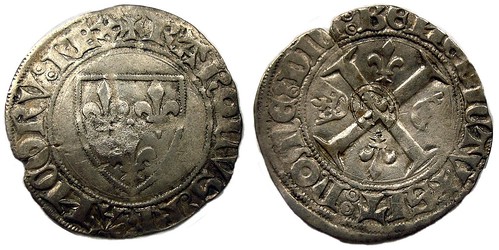
Lot 2: 1640 countermark on a Charles VI Blanc dit Guenar, 5th Emission
In 2004 Robert A. Vlack wrote a book on the French billon coinages intended for North America, giving variety and rarity information for the first time, especially useful for the Sous and Half Sous Marques – coins that had been around for 250+ years before this was finally attempted. More recently, Syd Martin’s 2015 book looked at the three coinages that were specifically struck for North America; of these types, only the 1721-2 Copper 9 Deniers are affordable and quite collectible, and Martin’s work has die variety and rarity information published for these, also for the first time – nearly three full centuries after those coins were struck! Most of the other French Colonies coinages have yet to be published in any sort of detail, offering a great opportunity for original numismatic research.
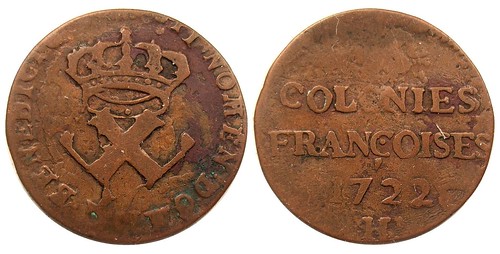
Lot 331: 1722-H Copper Nine Deniers
We are pleased to offer here an extensive collection of the coins that actually circulated in French North America – many of which continued to circulate in both Canada and the United States (especially the areas acquired as part of the Louisiana Purchase) into the early 19th century. A handful of extreme rarities are not included in this collection, such as the 1670-A silver 5 and 15 Sols and the 1717-Q copper issues of 6 and 12 Deniers. While their rarity is legendary, that same rarity also meant those coins would have seldom been seen in circulation. Instead, this collection focused on the coins that were used on a routine basis by those who lived in the region from the 1640s through the early 1800s, and shows the wide variety of coin types available. For struck coins this means date and mintmark combinations as well as major varieties; for countermarked or overstruck coinages it means the variety of different host coins by ruler, date and mint. These coins were made to circulate, not to be placed in the cabinets of European collectors, and while a few have survived in remarkably nice condition, others exist only well-worn, attesting to their long and useful life in commerce. This is a series that is focused less on perfect condition and more on the intrinsic history wrapped up in these rare surviving pieces of daily life.
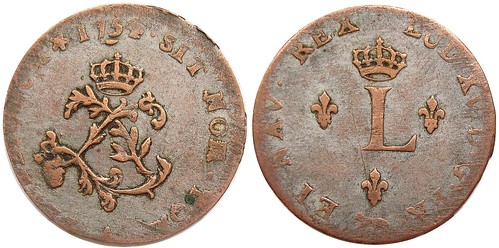
Lot 368: 1754-A Billon Sous Marques
This is one of the largest offerings of such coins at public auction, on par with the 500+ coin Robert A. Vlack collection sold in January, 2008 and the 450+ offering of the John J. Ford collection sold in January, 2006 – though each of these three collections are stronger in different areas. Both Ford and Vlack had more Sous Marques and Half Sous, and the Ford sale was remarkably strong in coinage from the treasure ship Le Chameau, while the present collection is far richer in the earliest issues, the 1640 countermarks and the Recoined Sol coinage.

Lot 502: 1767-A French Colonies Copper Sou
Included in this offering are many extremely rare pieces that have never appeared for public sale before, others that are completely unlisted in the scant reference material, and some other unusual delicacies. We have strived to make this more than just an auction catalogue to be discarded after the sale is done, but rather something that can be used as a reference work for the series as a whole. We have grouped the offering by series, each with a brief introduction tracing the coinage and its importance to Canada and North America. For collectors of both Canadian coinage and the American colonial series, this offering is one worthy of further study. For our bidders from the United States we remind you that the bids are in Canadian dollars, and the current exchange rate is heavily in your favor, making the series an even bigger bargain. Bonne chance!
To view the lots or bid, see:
http://auctions.gbellauctions.com/Toronto-Coin-Expo-Spring-Sale-2019_as56934
HERITAGE SALE ANTI-SLAVERY MEDALS
Mike Dlugosz is selling some interesting material in an upcoming Heritage sale and he submitted the following information. Thanks. -Editor
Abolition of Slavery in the Colonies Medal


The first medal up for auction is one of my all-time favorite acquisitions. It is a near-gem BHM-1669 which bears the same motto and general theme as Hardtimes token Low-54. BHM-1669 is a larger and much more refined production by expert English engraver and manufacture Thomas Halliday.
The obverse features a shackled female slave on bended knee, before a standing personification of Justice. Above, AM I NOT A WOMAN AND A SISTER. Below, LET US BREAK THEIR HANDS ASUNDER AND CAST AWAY THEIR CORDS. PSALM II:3. On the reverse is a wreath laced with a ribbon that bears the names of prominent British abolitionists.
Examples of this medal appear on occasion. They are virtually always in white metal and with hairlines, rim bruising and at least a few tiny spots of corrosion. So naturally I wanted to beat the odds and find an excellent problem-free unc. I was elated when the presently offered specimen crossed my path. I consider this extremely rare as it is not only finer than any other BHM-1669 that I could trace, but is far rarer to begin with, having been stuck in bronze.
I thought the grade given by NGC to be a bit conservative. It’s stunning in hand; the surfaces are lustrous and essentially free of the type of distractions and hairlines that can often be inclusive of an MS64. I was pleasantly surprised to see the cataloger at Heritage had picked up on the same and noted such in the lot description. He/She arrived at that conclusion independently of my own thoughts as I had not communicated this to HA.
Here is the full description given by the cataloger:
A great medal, and historically important. -Editor
To read the complete lot description, see:
Great Britain: temp. William IV bronze "Abolition of Slavery in the Colonies" Medal ND MS64 Brown NGC,...
(https://coins.ha.com/itm/great-britain/world-coins/great-britain-temp-william-iv-bronze-abolition-of-slavery-in-the-colonies-medal-nd-ms64-brown-ngc-/a/3073-33065.s)
Abolition of Slavery throughout the British Colonies Medal

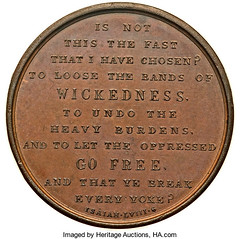
The second Anti-Slavery medal is BHM-1672 which commemorates the Abolition of Slavery throughout the British Colonies in 1834. On the obverse a newly emancipated man stands centered with arms extended. Broken shackles and chains dangle from his hands and lay at his feet. Rays of Glory shine down on him and his wife and his child. They are seated at the ground on either side of him. Above, LIBERTY PROCLAIMED TO THE CAPTIVES. Below, IN THE REIGN OF WILLIAM IV 1ST AUGT 1834.
The reverse features an excerpt from Isaiah-58:6
The medal is a very rare variety. The reverse is commonly seen paired with a different obverse. Like the last piece, this is struck in bronze and remains in a rather exquisite state of preservation. It is unlisted in Eimer and I’ve not seen another in bronze nor in any composition at a comparably high grade.
Here is the full description given by the cataloger:
William IV bronze "Abolition of Slavery in the Colonies" Medal 1834 MS64 Brown NGC, BHM-1672 (RR), Eimer-Unl. 44mm. A quite clearly specimen-level striking of this popular and especially historic medal, the surfaces glass-like with underlying blue and gold hues and a glossy high relief to all the devices. Very rare in both this metal and near-gem quality, wholly original and unpierced, and free of all but the most unintrusive of marks.
Another great medal. Wordy, but where else on a medal will you see the phrase "Bands of Wickedness"? -Editor
To read the complete lot description, see:
Great Britain: temp. William IV bronze "Abolition of Slavery in the Colonies" Medal 1834 MS64 Brown NGC,..
(https://coins.ha.com/itm/great-britain/great-britain-temp-william-iv-bronze-abolition-of-slavery-in-the-colonies-medal-1834-ms64-brown-ngc-/a/3073-33064.s)
NUMISMAGRAM MEDAL SELECTIONS: APRIL 2019
Numismagram's Jeremy Bostwick passed along these highlights from his most recent upload of new material for April. This group of 20 items has a particular focus on the theme of aviation in the realm of medallic art. Zeppelins especially feature prominently on many of the pieces, as well as the men behind the company which manufactured them. This upload is rounded out by some gem British coronation medals, a few attractively toned German World War I silver medals, a bronze plaque for the 1900 Paris expo designed by famed engraver Victor David Brenner, a couple bronze award medals for the 1904 St. Louis expo designed by another famed engraver, Adolph Alexander Weinman, and a pedigreed Washington 'Star' medal. Visit numismagram.com/inventory for all of the new items. -Editor
Death & Resurrection Medal

100557 | HOLY ROMAN EMPIRE. Bohemia. Death & Resurrection cast silver Medal. Issued circa 1563. Jonah and the whale/the Resurrection (47mm, 35.32 g, 12h). Possibly by N. Milicz. SICVT IONAS IN VENTRE CETI TRIDVV LATVIT ET INDE REDIIT INCoLVIS ION Z (just as Jonas spent three days in the belly of a whale and thence returned uninjured...), Jonah and the Whale: seaside scene, with fortifications of Ninevah (now Mosul, Iraq) on the embankment; in the harbor, whale attacking a ship and consuming a fallen Jonah; in foreground, the same whale from which Jonah now flees after three days / ITA CHRISTVS TRIDVV SEPVLTVS POST DEVICTOS HOSTES RESVREXIT MA XI (...so too did Christ spend three days in the heart of the earth and was resurrected after having overcome his enemies), the Resurrection: Christ emerging from a crypt, holding cruciform banner and stomping upon serpent on the Gospels; city walls and trees in background. Edge: Plain. GPH 69. Extremely Fine. Lightly toned, some scattered marks. An attractive religious-themed type. $645.
This medal recounts the biblical stories of Jonah and the whale and of the resurrection of Christ. In the first (represented on the obverse), God commands Jonah to travel to Ninevah and warn her residents of God's impending wrath. Jonah ignores the command, and instead boards a ship bound for Tarshish. During the travels, the ship is caught in a roiling tempest, and the crew realizes that Jonah is to blame. When he is cast off the ship, a whale (or very large fish) swallows him whole, and Jonah then spends three days within the gigantic creature. When Jonah finally relents and agrees to God's commands, the whale then vomits him upon the shores of Ninevah, whereupon he fulfills his duty, thus saving the city from assured destruction through their repenting. In the second (represented on the reverse), Jesus is shown emerging from a crypt, similarly after three days, whereupon his death and subsequent resurrection in biblical tradition has a more global effect, in that not just Ninevah is redeemed, but the entire world. Ninevah herself, now corresponding to the modern city of Mosul in Iraq, suffered much destruction to her classical sites, such as the Tomb of Jonah (Yunus), at the hands of ISIS in the spring of 2014.
There's a lot going on in these scenes. Interesting medal. -Editor
To read the complete item description, see:
100557 | HOLY ROMAN EMPIRE. Bohemia. Death & Resurrection cast silver Medal.
(https://www.numismagram.com/product-page/100557)
Icarus Flight Medal
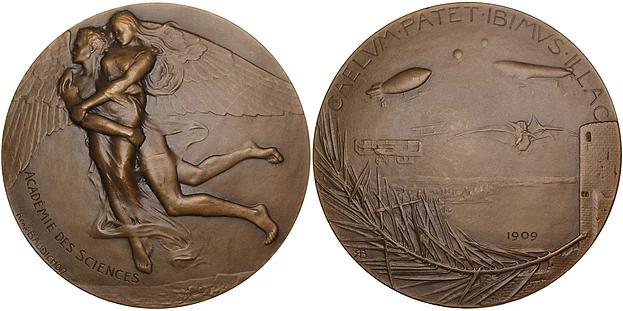
100603 | FRANCE. Académie des Sciences bronze Medal. Issued 1909. The Marvel of Aviation (65mm, 115.79 g, 12h). By R. Baudichon. ACADÉMIE DES SCIENCES, Icarus flying left, holding in his arms a female / CAELVM PATET IBIMVS ILLAC (the sky is opened, and we shall go that way, —adapted from Book 8 in Ovid's Metamorphoses), various modes of early aviation: balloons, airships, and propeller planes, all flying over a harbor; castle turret to near right, branch in foreground. Edge: «cornucopia» BRONZE. Malpas 424. Choice Mint State. Attractive yellow-brown surfaces, with a charming matte nature. Rare. $435.
The quote on the reverse is adapted from one of Ovid's books in his Metamorphoses, chiefly from the story of Dædalusand Icarus, in which master craftsman father Dædalus constructs wings, made from feathers and wax, for his son Icarus, whom he warns against both complacency and hubris—complacency of flying too low to the sea and allowing the dampness to clog the wings, hubris of flying too high near the sun and allowing the heat to melt the wax. Icarus ignored these warnings, flying too close to the sun, and drowning in the sea when the wings failed him. This medal points to the dawn of modern aviation and the hope of continuing to perfect aviation without the perils of Icarus.
A beautiful medal - simple, elegant design. -Editor
To read the complete item description, see:
100603 | FRANCE. Académie des Sciences bronze Medal.
(https://www.numismagram.com/product-page/100603)
Von Zeppelin - Hugo Eckener Medal

100612 | GERMANY. Ferdinand Adolf Heinrich August Graf von Zeppelin & Dr. Hugo Eckener silver Medal. Issued 1928. The commissioning of the LZ-127 (33mm, 13.79 g, 12h). By L. C. Lauer in Nürnberg. FERDINAND GRAF ZEPPELIN 1838-1917 / DR HUGO ECKENER 1868, jugate heads of Zeppelin and Eckener left / DEUTSCHE KRAFT UND DEUTSCHER GEIST / WERK DAS "AUFSTIEG" "FREIHEIT" HEISST!, allegorical figure of Victory standing left, with wings spread, atop the airship; "GRAF ZEPPELIN" / D-LZ 127 / INDIENSTSTELLUNG / 20 SEPT. 1928. Edge: 990.
Hans Kaiser Coll. 479. Choice Mint State. Wondrous prooflike surfaces, with a light golden-cobalt tone throughout; a few light marks in the fields are noted merely for completeness. $285.
Zeppelin was a German general and aircraft manufacturer, who later founded the airship company Luftschiffbau Zeppelin. Following Zeppelin's death in 1917, Dr. Hugo Eckener became the head of this company and oversaw post-war fundraising to expand upon its production, even serving as commander for the LZ 127 on numerous occasions. When this airship first entered use, it was the first commercial passenger transatlantic flight service in the world, eventually making 590 flights over nearly a decade. In 1940, she was scrapped for metal for the German efforts in World War II.
To read the complete item description, see:
100612 | GERMANY. Graf von Zeppelin & Dr. Hugo Eckener silver Medal.
(https://www.numismagram.com/product-page/100612)
Switzerland Carnegie Hero Fund Medal
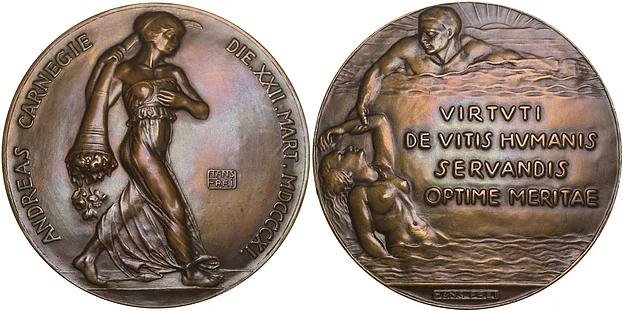
100621 | UNITED STATES & SWITZERLAND. Carnegie Hero Fund (Switzerland) bronze award Medal. Instituted 1911. Presented by the Swiss chapter (70mm, 146.45 g, 12h). By H. Frei. ANDREAS CARNEGIE DIE XXII MART MDCCCCXII, female figure advancing right, holding overturned cornucopia / VIRTVTI / DE VITIS HVMANIS / SERVANDIS / OPTIME MERITAE, male rescuing female from drowning in the ocean. Edge: «cornucopia» BRONZE. Mint State Light yellow-brown surfaces. Rare. $325.
The Scottish-American steel magnate and philanthropist, Andrew Carnegie, created the Carnegie Hero Fund in 1904 to honor and recognize citizens who performed acts of heroism and bravery in the United States. A few years later, he created a similar fund for other countries in Europe to serve a similar purpose. This piece, designed by Hans Frei, displays the elegant and soft beauty more commonly encountered in his numerous Swiss shooting medals.
I collect Carnegie Hero medals, and I have one of these. A beautiful medal, especially the reverse. -Editor
To read the complete item description, see:
100621 | UNITED STATES & SWITZERLAND. Carnegie Hero Fund bronze award Medal.
(https://www.numismagram.com/product-page/100621)
Hindenburg Birthday Medal

100609 | GERMANY. Reichspräsident Paul von Hindenburg silver Medal. Issued 1927. Commemorating his 80th birthday (33mm, 15.01 g, 12h). By L. C. Lauer in Nürnberg. REICHSPRÄSIDENT VON HINDENBURG / 80 GEBURSTAG 2 OKT 1927, bust facing slightly left / Eagle, with head left and wings spread, standing facing on base; laurel branch below. Edge: 990. Gem Mint State. Fully prooflike surfaces, with an intensely brilliant cameo nature. A stunningly attractive specimen. $225.
Before serving as the president of the German Reich and his unintended role in giving rise to nazism and Adolf Hitler in 1933, Paul von Hindenburg was a celebrated general within the German Empire, first retiring in 1911. Upon the outbreak of WWI, however, he was called upon to serve once again, where he oversaw a major and much celebrated German victory at Tannenberg in 1914. Following this campaign, Hindenburg's star rose to a national level, paving the way for his ensuing political career during the Weimar period.
To read the complete item description, see:
100609 | GERMANY. Reichspräsident Paul von Hindenburg silver Medal.
(https://www.numismagram.com/product-page/100609)
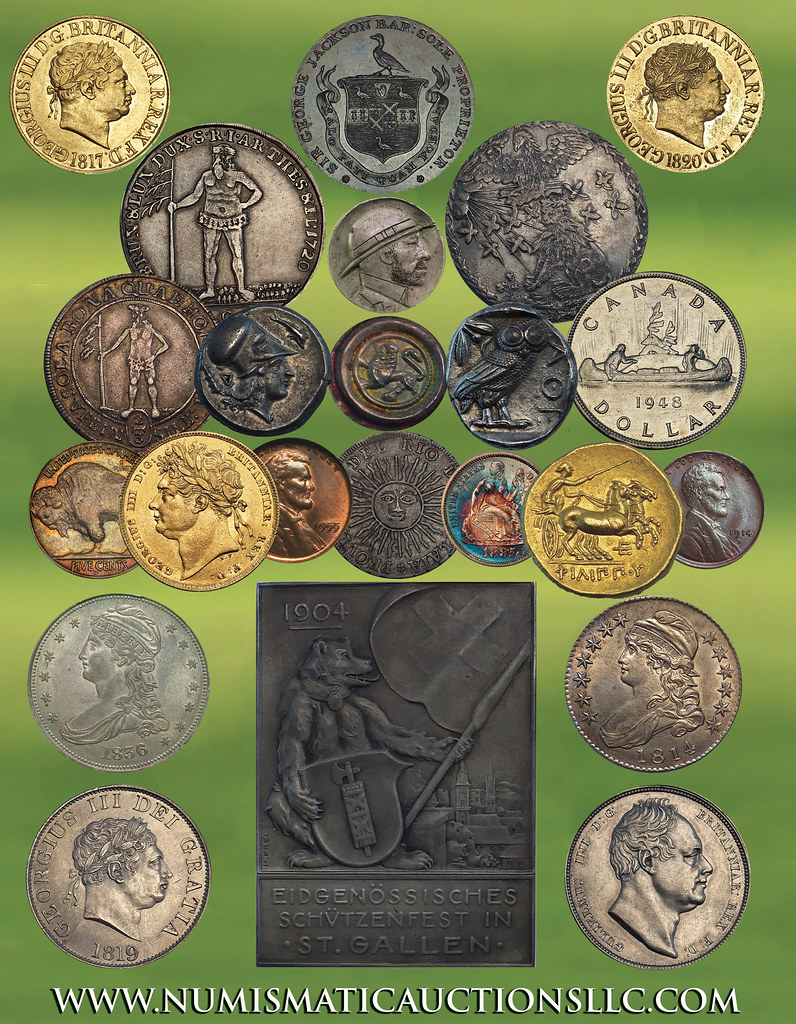
NUMISMATIC NUGGETS: APRIL 7, 2019
Here's a selection of interesting or unusual items I came across in the marketplace this week. Tell us what you think of some of these. -Editor
Moesia, Istros Stater
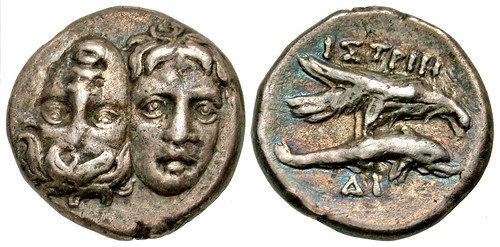
Moesia, Istros. civic issue. 400-350 B.C. AR stater (18 mm, 5.22 g, 7 h). Facing young male heads, side-by-side, left head inverted / Sea-eagle right grasping dolphin in talons, control letters ?I beneath dolphin. Cf. SNG Cop 194 (controls). EF, medium toning, trending to rainbow on reverse.
From the D. Thomas Collection.
Unusual double portrait, to say the least. So weird I like it. I think I highlighted one of these before. From the Agora Auctions sale #84 closing April 9, 2019. -Editor
To read the complete lot description, see:
Lot 006. Moesia, Istros. civic issue. 400-350 B.C. AR stater. From the D. Thomas Collection.
(https://agoraauctions.com/listing/viewdetail/43711)
1848 Central Bank of Scotland Five Pounds Proof Cancelled

A cancelled proof of the Central Bank of Scotland. From Pam West's Newsletter 113, A Bank Note Affair. -Editor
To visit Pam's web site, see:
http://britishnotes.co.uk/
WAYNE'S NUMISMATIC DIARY: APRIL 7, 2019
Welcome Banquet
Last week I made a trek to Pittsburgh to attend part of the American Numismatic Association National Money Show. After driving up Wednesday morning and visiting an uncle after lunch, I checked into the Hampton Inn & Suites across from the Pittsburgh History Center. About 6pm I met up with our NBS webmaster Bruce Perdue who had driven in from Chicago. We walked over to the Westin and hopped aboard the shuttle bus that would take us to the Welcome Banquet co-sponsored by the ANA and the Pennsylvania Association of Numismatists (PAN).
Aboard the bus I found John and Nancy Wilson, Bryce Doxson and Simcha Kuritsky in the front seats. Other passengers included Mark Lighterman, former U.S. Mint Engaver Don Everhart, Don Kagin and Ken and Tom Hallenbeck. Bruce showed me some souvenirs from the recent Chicago Coin Club 1,200th meeting. Don Kagin handed me a nice gold-colored token promoting his candidacy for the ANA Presidency picturing an octagonal $50 gold slug on the reverse.
After a slog through rush-hour traffic we wended our way up the long hill above the Monongehela river to the LeMont restaurant and its commanding view of downtown Pittsburgh.

As we waited to enter our dining area several of us enjoyed the artwork on the restaurant walls.
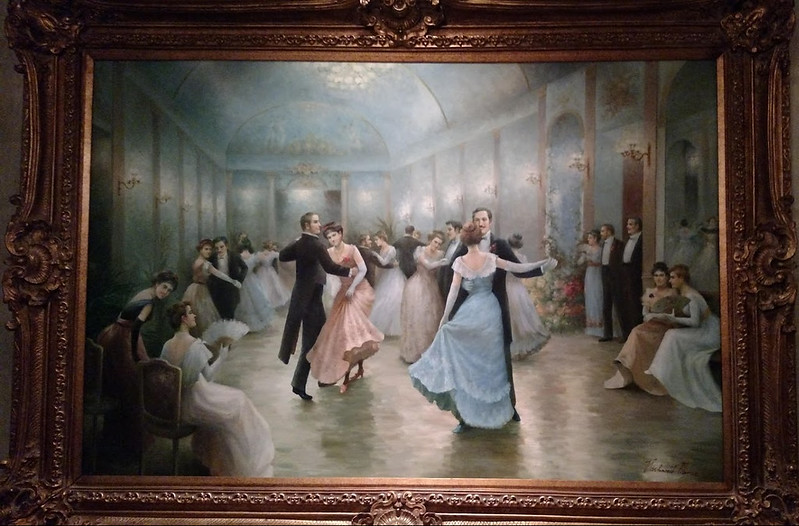
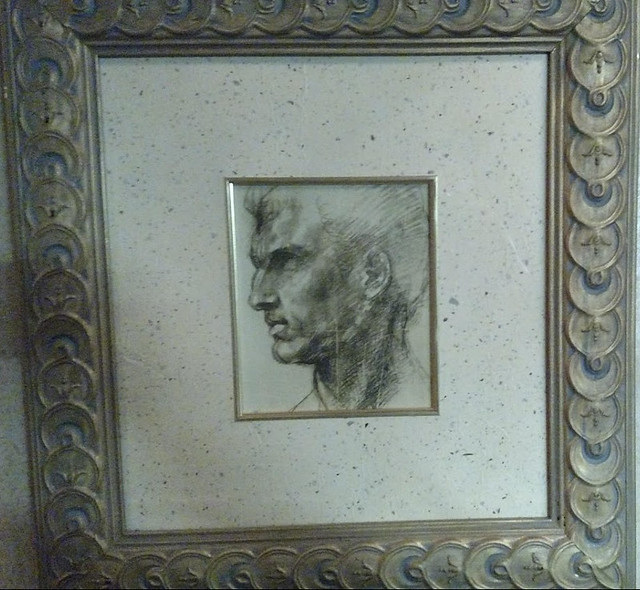
Don Everhart leaned close to inspect the work on this one.
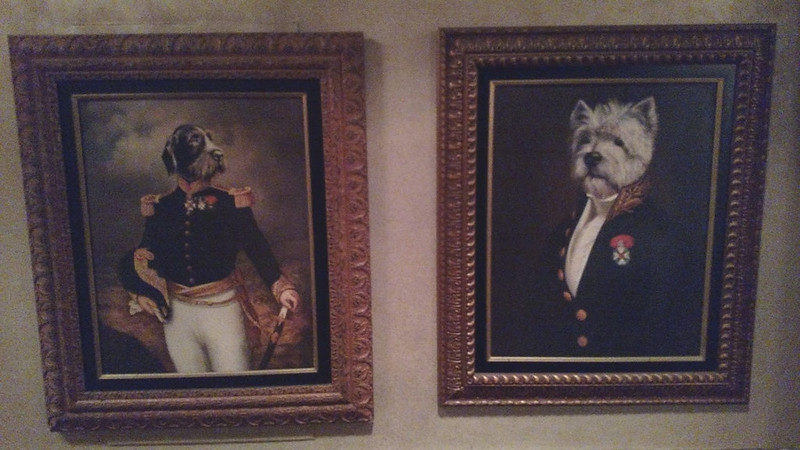
No masterpieces, but a lot of whimsy


Guests were treated to a live performance by the Washington, PA Jazz Orchestra. The sound overwhelmed the small space making conversations difficult at times, but it was very enjoyable. I walked around a bit and spoke with ANA Executive Director Kim Kiick, Museum Director Doug Mudd, Membership Director Cary Hardy and the new advertising sales manager Nathan McAllister. Other attendees I spoke with included PAN Chairman of the Board Don Carlucci, PAN Publicity Director Pat McBride and other locals including Dick Gaetano, Larry Korchnak and Tom and Gosia Fort.
It was great to visit with old friends. Gosia, Tom, Larry and Bruce Perdue shared my table. We caught up on family news, and Larry showed me part of his manuscript on Obsidinal Coins of the World (1453-1902).
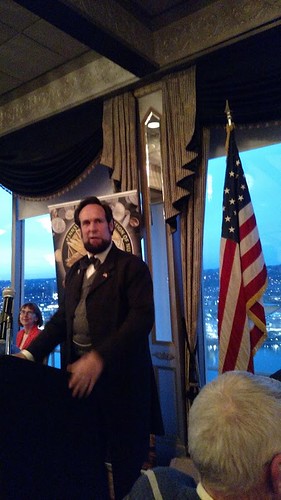

LEFT: Abraham Lincoln, 16th President of the United States
RIGHT: David J. Ryder, 34th and 39th Director of the U.S. Mint
The crowd was treated to a stirring performance by Abraham Lincoln impersonator Dennis Boggs and an excellent talk by U.S. Mint Director David Ryder. PAN knows how to throw a great event. I'll stop there - a much more detailed report with photos will be published by PAN in their journal and on the club web site.
As the event wound down I had a chance to speak briefly with Director Ryder. On the right is a photo of a photo - the event photographer captured the official picture while Tom Uram snapped this pose.


LEFT: David Ryder and Wayne Homren
RIGHT: Pat McBride, David Ryder and Wayne Homren
The National Money Show
After breakfast Thursday morning I headed over to the convention center. I spoke to a number of people including Pittsburgh natives Dick Gaetano and Larry Dziubek, and out-of-towners Greg Ruby, Jon Sullivan, Tom Caldwell and Chris Clements of Northeast Numismatics, Clifford Mishler and Barbara Gregory, editor of The Numismatist. Here are some photos I took around the hall.
John and Nancy Wilson

Nancy Wilson (seated), her husband John and former ANA employee (and now ANA National Volunteer) Sandi Hill manned the Future Conventions booth.
Jessie Zhang

Dealer Jessie Zhang of California and I had a nice conversation about her business and upcoming coin shows.
Jeff Shevlin


I met the "So-Called Guy" and former ANA Executive Director Jeff Shevlin and his wife at their table. Jeff is hard at work on an update to the Hibler-Kappen So-Called Dollars book. At right is his priceless dog-eared, annotated copy of the reprint.
John Dannreuther
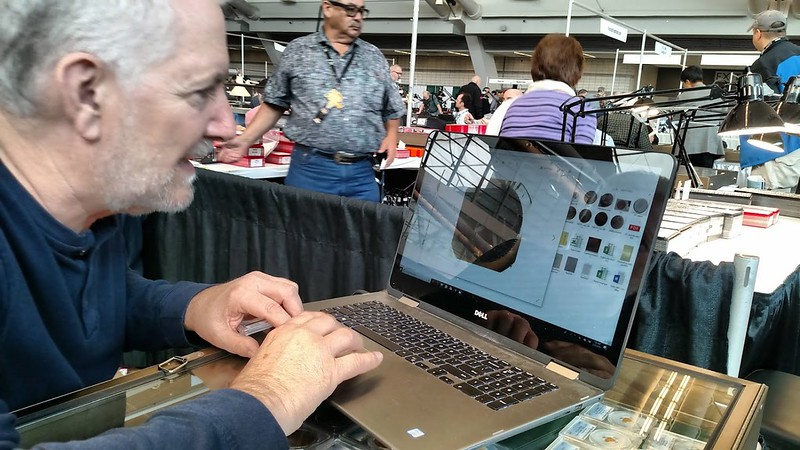
I sat down at the table of John "JD" Dannreuther and had a long discussion about his research with Craig Sholley on the Fugio Cent dies. They're doing some great work and I'll look forward to the publication of their conclusions. I took this cameo shot of the master at work poring over photographic evidence.
ANA Exhibits
The ANA Museum had some nice exhibits. Here are the Bebee paper money errors and the copper 1943 cent.
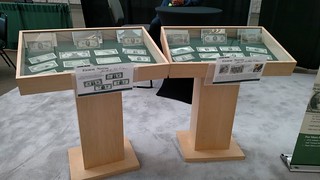

It was a whirlwind trip. I had to leave long before I was done having fun and seeing everyone I wanted to. I took a nice walk thru downtown Pittsburgh to view all the changes that had taken place in the years I've been away. I stopped at our family plots in Allegheny Cemetery and met with our accountant to finish up our 2018 tax forms before hitting the road after a fast food dinner at 6pm.
Along the drive I was listening to tunes on Spotify when I heard a nicely done ad for the National Money Show at the Pittsburgh Convention Center. I made it home to Virginia by 10pm, just in time to unpack, call it a night and get back to my office on Friday. 'Til next time!
Pat McBride reports:
Saturday was loaded with families and kids. We had nonstop traffic at our PAN table; unprecedented for the club midway area. It was a good show with a lot of good reports from various dealers.

Here's the Day #1 show volunteer group photo. Great job, everyone! -Editor

NUMISMATICS AT THE NATIONAL MUSEUM IN KRAKOW
Numismatourist Howard Berlin filed this report from Krakow, Poland. Thanks! -Editor
 My second trip of the year took me to Krakow, Poland in March. The morning of my second day was spent at the Numismatic Room at the National Museum in Krakow’s Emeryk Hutten-Czapski Museum, a branch of the National Museum in Krakow. The building sort of reminded me of the Numismatic Museum Athens, whereby it was transformed from the residence of its prolific collector (archeologist Heinrich Schliemann) to a museum. This museum was the home of Emeryk Hutten-Czapski (1828-1896), a Polish Count, scholar and numismatist.
My second trip of the year took me to Krakow, Poland in March. The morning of my second day was spent at the Numismatic Room at the National Museum in Krakow’s Emeryk Hutten-Czapski Museum, a branch of the National Museum in Krakow. The building sort of reminded me of the Numismatic Museum Athens, whereby it was transformed from the residence of its prolific collector (archeologist Heinrich Schliemann) to a museum. This museum was the home of Emeryk Hutten-Czapski (1828-1896), a Polish Count, scholar and numismatist.
The Numismatic Room was established in 1883 and following Czapski's death, his widow in 1903 donated the entire collection, which along with subsequent future benefactors, became the repository of the most representative collection of Polish coins, medals and banknotes. Upon arrival, I was met by the museum’s head of numismatics, Prof. Jaroslaw Bodzek, who is also on the faculty of the Department of Archeology at Jagiellonian University.
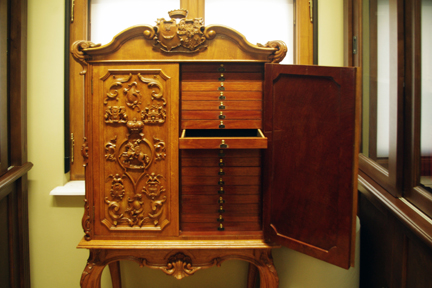


Currently, the museum boasts a collection of approximately 109,000 objects. It comprises items such as about 9,000 antique coins, 60,000 Polish and foreign coins, 7,000 medals, 2,500 religious medallions, and 19,000 banknotes. It also has a numismatic library of about 3,000 books. The numismatic galleries occupy both floors of the building. The well-curated displays were in both Polish and English.

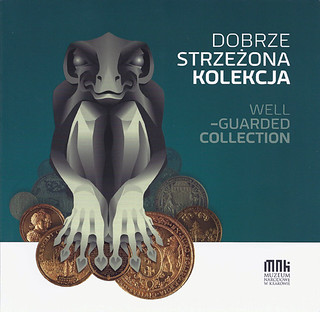
100 Numismatic Rarities at the National Museum in Krakow (2012). 9”x12” casebound w/dust jacket, 226 pages in Polish and English. ISBN 978-83-7581-029-5
Well Guarded Collection (2013). Joana Popielska (Ed.). 8”x8” paperback, 44 pages in Polish and English. ISBN 978-83-7581-116-2
 As it often turns out, my museum visits often have me leaving with one or more (often heavy) books given to me as gifts by the museum. This time, I received two books, one of which was a massive “coffee table” book about the 100 Numismatic Rarities at the National Museum in Krakow, which weighed about 2.9 pounds (1.3 kg). A second, but smaller book was about the museum, its numismatic history and collection. If that wasn’t enough, I also received a museum souvenir which took me about a minute to figure out what it was – it is an 8 GB thumb drive. The USB connector extends and retracts by twisting the top disc clockwise/counter-clockwise. Neat!
As it often turns out, my museum visits often have me leaving with one or more (often heavy) books given to me as gifts by the museum. This time, I received two books, one of which was a massive “coffee table” book about the 100 Numismatic Rarities at the National Museum in Krakow, which weighed about 2.9 pounds (1.3 kg). A second, but smaller book was about the museum, its numismatic history and collection. If that wasn’t enough, I also received a museum souvenir which took me about a minute to figure out what it was – it is an 8 GB thumb drive. The USB connector extends and retracts by twisting the top disc clockwise/counter-clockwise. Neat!
SEAL OF KING JOSIAH COURT OFFICIAL FOUND
Larry Dziubek forwarded this article from the Jewish Press. Thanks. Seals are closely related to coins and studied and collected alongside them in many circles. -Editor

A bulla (seal impression) and a 2,600-year-old stamp dating back to the First Temple and bearing Hebrew names were recently uncovered as part of the archaeological excavations of the Givati Parking Lot in the City of David National Park in Jerusalem. The dig was conducted by archaeologists from the Israel Antiquities Authority and Tel Aviv University.
Both artifacts will be presented in the Israel Exploration Journal, published by the Israel Exploration Society.
Bullae were small pieces of clay impressed by personal seals, used in ancient times to sign letters. While the parchment they sealed didn’t survive the fires that devastated ancient Jerusalem, the bullae, which are made of ceramic-like material, were preserved, leaving evidence of the correspondence and those behind them.
Private stamps were used to sign documents, and were often set in signet rings carried by their owners. In ancient times these stamps noted the identity, lineage and status of their owners.
For another article about ways people authenticate documents, see the piece elsewhere in this issue about the artist Banksy. -Editor
To read the complete article, see:
Seal Bearing Name of King Josiah’s Court Official Uncovered in City of David
(https://www.jewishpress.com/news/israel/jerusalem/seal-bearing-name-of-king-josiahs-court-official-uncovered-in-city-of-david/2019/03/31/)
DETECTORIST FINDS AUREUS OF EMPEROR ALLECTUS
Arthur Shippee forwarded this article, which was found via The Explorator newsletter. Thanks. What a monster coin! -Editor


A rare 24-carat gold coin almost 2,000 years old has been discovered by an amateur metal detectorist in a field in Kent, England, near the site of an ancient Roman road. Now it could sell for as much as £100,000 ($130,000) when it hits the block at London auctioneers Dix Noonan Webb on June 12.
“This really is the find of a lifetime for me and the greatest discovery I have made by miles,” the 30-year-old artist who found the coin told the Daily Mail, noting that he’s been using a metal detector for seven years. “At first I was quite skeptical of its authenticity because it was so shiny, but when I realized what it could be potentially, I just completely freaked out.”
The coin bears the visage of the Roman Emperor Allectus with two kneeling captives at the feet of the god Apollo on the obverse.
In power from 293 to 296 AD, Allectus was one of two Roman emperors who ruled Britannia and northern Gaul as an independent nation between 286 and 296 AD. The Daily Mail has dubbed him a “Brexiteer of his day” for taking Britain out of the Roman Empire. (Last month, the British Museum held a talk titled “The First Brexit,” which considered Allectus’s reign as a historical precedent for the nation’s looming exit from the European Union.)
The British Museum owns the only other known example of a gold Allectus aureus, and no one has discovered a coin bearing his visage in 50 years. An expert from the museum authenticated the find.
Because only one coin was found at the site, the antiquity does not fall under the UK’s Treasure Act and it is allowed to go to auction. The proceeds will be split between the finder and the landowner.
To read the complete article, see:
An Amateur Metal Detectorist Found an Ancient Roman Coin Depicting the ‘First Brexiteer’ in an English Field
(https://news.artnet.com/art-world/metal-detector-discovers-golden-roman-coin-1509847)
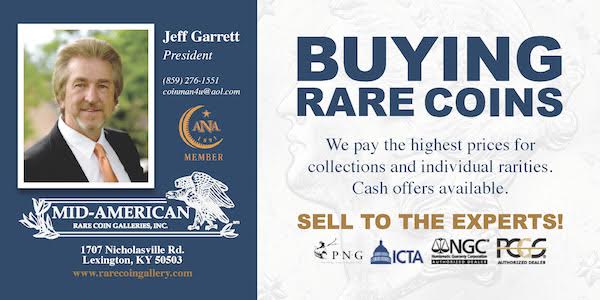
JERSEY COIN HOARD FINDERS AWAITING REWARD
David Pickup forwarded this article from The Times about the finders of that massive Celtic coin hoard in Jersey. -Editor
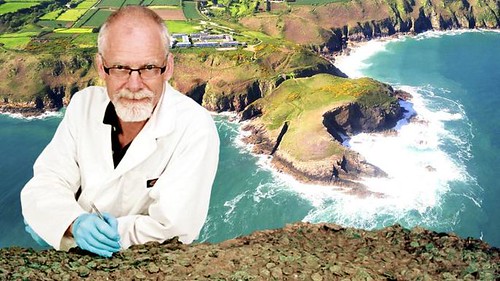
Friends who unearthed treasure after a 30-year search must wait a little longer for their millions
Two metal detectorists who discovered an unprecedented treasure trove of coins after searching for 30 years may be wishing that finders were indeed keepers.
Richard Miles, 56, and Reg Mead, 77, are at odds with officials over the valuation of their discovery in Jersey that is recognised as the world’s largest hoard of Celtic coins.
Buried 2,000 years ago by Celts fleeing Julius Caesar’s Roman armies, the treasure contains about 70,000 coins as well as gold jewellery — possibly the first use of Jersey as an offshore bank.
David adds:
My very limited experience of French metal detecting law is very different. I offered a medieval coin to a museum in England and when they found it had been found in France by a metal detectorist they rejected it as by law it should have been given to the state. They eventually agreed to take it when the French authorities consented.
To read the complete article (subscription required), see:
Jersey coin finders are not keepers
(https://www.thetimes.co.uk/article/jersey-coin-finders-are-not-keepers-t0qhv2c0j)
To read the earlier E-Sylum article, see:
JERSEY GROUVILLE HOARD WAS TWO COLLECTIONS
(https://www.coinbooks.org/v22/esylum_v22n12a24.html)
SONAR ENGINEERS COLLECT CENTRAL AMERICA SHARE
Another group that's been awaiting an award is profiled in this April 4, 2019 Seattle Times article. The sonar engineering team helped locate the wreck of the SS central America, source of the famous trove of gold coins and bars. -Editor

Mike Williamson, left, and Tim McGinnis hold the control panel that McGinnis, an ocean engineer, built part of the specialized sonar that eventually found the sunken SS Central America.
Trouble and treasure hunting just seem inseparable, as 13 individuals, most from the Seattle area, found out.
They were the engineers, technicians and owners of high-end sonar equipment who were promised a small share of the wreck’s bounty in return for their work, which found the Central America in 1988, some 160 miles off the South Carolina coast, 7,200 feet down on the ocean floor.
It took nearly 30 years of litigation and reams of legal documents before a court settlement got them at least a portion of what they were owed. The last of two payments arrived in February.
For the 12 men and one woman – after attorney and legal fees totaling $522,000 — $678,000 was left to be divided in different percentages.
Says Tim McGinnis, 66, now an ocean engineer at the University of Washington and who was part of the search crew, “It’s enough for a decent car, better than I was expecting.”
Mike Williamson, a geophysicist, is 73. He was 40 back in 1986 when his oceanography firm at Fishermen’s Terminal, one bearing his last name, did the work that helped find the steamship.
“It was a great adventure, no doubt,” he says. “But the aftermath, the lack of justice . . . I’m glad it’s over.”
To read the complete article, see:
Seattle group helped find 15 tons of gold lost on sunken ship. It took 30 years to get their shares.
(https://www.seattletimes.com/seattle-news/the-ss-central-america-ship-of-gold-and-lost-lives/)
CENTRAL GLASS COMPANY COIN GLASS
This March 8, 2019 WorthPoint article by Mike Wilcox of Wilcox & Hall Appraisers discusses coin glass. -Editor

Central Glass Company “Coin Glass” bread tray.
Our client writes:
“I picked up this strange looking piece at an auction years ago, it’s a glass tray with a coin design impressed in it. I got it cheap and until recently have used it as a catch all for loose change and keys. I had a guest to my home say it dates from the 1800’s and thought I’d better have it valued. There are no markings on it and it measures 10? X 8?, in good condition with no chips, scratches or cracks.”
Our conclusion:
Based on the images, this is a Central Glass Company “Coin Glass” bread tray, decorated with cast American 1892 coin impressions. The original “coin glass” was produced in 1892 by the Central Glass Company of Wheeling, West Virginia. The company was a manufacturer of glassware of a mainly inexpensive variety with a wide market in mind. The novelty of the coin glass product line was an attempt by the company to further broaden its sales countrywide.
A number of denominations were used in the coin glass line, mainly silver dollars and silver half dollars, but the dime, quarter, twenty cent piece, and three cent pieces were also used. Items in this novelty glass line included cake stands, footed bowls, celery dishes, goblets, sauce dishes, bread trays, syrup pitchers and pickle dishes. There are also spooners, jugs, footed sauces, and lamps.

This Central Glass Co. coin glass rectangular tray sold for $76.01 in 2012.
Production was short for this product line. Only five months of actual production occurred before the Treasury Department declared that the process was actually a form of counterfeiting and destroyed the molds. In the current market, your Central Glass Company bread tray would sell at auction in the $50.00- $80.00 range(USD). The example above from our Worthopedia sold for 76.01. The one below sold for $71.00.

This Central Glass Co. tray sold for $71 in 2013.
 To read the complete article, see:
To read the complete article, see:
FROM THE WORTHOLOGISTS’ FILES: COIN GLASS
(https://www.worthpoint.com/articles/glass/from-the-worthologists-files-coin-glass)
To read earlier E-Sylum articles, see:
A LIBERTY SEATED QUARTER COIN GLASS SAUCE DISH
(https://www.coinbooks.org/esylum_v15n10a17.html)
ANOTHER LIBERTY SEATED COIN GLASS SAUCE DISH
(https://www.coinbooks.org/esylum_v16n20a16.html)
BOOK: U.S. COIN & COLUMBIAN COIN PATTERN GLASS
(https://www.coinbooks.org/esylum_v16n21a04.html)
MORE ON COIN GLASS
(https://www.coinbooks.org/esylum_v16n22a15.html)

HIGHLANDERS MUSEUM DISPLAYS VICTORIA CROSSES
A museum in the Scottish Highlands has mounted a display of sixteen original Victoria Cross medals. -Editor
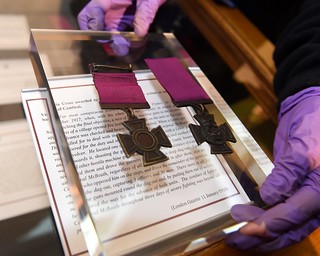 A north museum has unveiled a special exhibition of 16 original Victoria Crosses awarded to Highlanders, Seaforths and Camerons down the generations.
A north museum has unveiled a special exhibition of 16 original Victoria Crosses awarded to Highlanders, Seaforths and Camerons down the generations.
Military delegates and direct descendants gathered yesterday as the prestigious medals were gathered and put on display in the Highlanders’ Museum at Fort George.
The VC is the highest award given to members of the British Armed Forces.
Major Maurice Gibson, chairman of the Highlanders Museum and Donald Cameron, Lord Lieutenant of Inverness-shire, addressed the gathered audience in the Grand Magazine of the military barracks, speaking of the “conspicuous bravery” shown by all 16 recipients of the major honour.
Previously only replicas of the famed medals have been showcased, but now following a £2.9 million revamp of the museum, which was completed in 2013, stronger security has allowed for the genuine item to now go on display.
Lord Lieutenant Cameron said: “It is amazing that there are people who are descendants of those who were awarded the Victoria crosses here, I think it makes it much more poignant and I am just amazed by the bravery of these people.
To read the complete article, see:
Bravery and valour of Highland soldiers celebrated as 16 Victoria Crosses put on display at Fort George
(https://www.pressandjournal.co.uk/fp/news/highlands/1717652/bravery-and-valour-of-highland-soldiers-celebrated-as-16-victoria-crosses-put-on-display-at-fort-george/)
BANKSY’S CHIROGRAPH SYSTEM
In the everything-old-is-new-again department, this article describes the authentication system used by the artist Banksy. It has two numismatic connections. First, it involves examples of the artist's own genuine/fake "Di-faced tenner" notes, and a random tear in the note just like the system used for indentured notes in the U.S. colonial era (and long before that into medieval times). -Editor

Banksy's Di-faced Tenner
Part of the appeal of the artist Banksy is his/her/their anonymity. Despite continuing announcements of Banksy’s identity being revealed, no one is really sure who Banksy is (and to further add to the confusion, a well-known time traveler recently hinted that she was — or maybe wasn’t — Banksy). Regardless, collectors of art by an anonymous creator face a difficult problem of authenticating any individual artwork. For a public piece of graffiti, Banksy’s official website will confirm or deny whether it was painted by the artist.
But how do you know that the print or painting you’re buying is the real deal? Gallery authenticity certificates can be as readily forged as paintings. So in 2009, Banksy launched Pest Control, a not-for-profit company to sell and authenticate artworks. Basically, you submit images of the print or artwork, and if it is deemed authentic, for £65, you receive a certificate of authenticity, which includes half of a “Di faced tenner”, a torn in half fake £10 note created by Banksy with Lady Diana’s face on it (an example can be seen here). The half-note has a handwritten ID number on it which can be matched to the other half of the note held by Pest Control.
This offers a fairly clever authentication system:
The tear is what uniquely separates the private key, the half of the note kept secret under lock and key at Pest Control, with the public key. The public key is the half of the note attached to the authentication certificate which gets passed on with the print, and allows its authenticity to be easily verified.
We have no idea what has been written on Pest Control’s private half of the note. Which means it can’t be easily recreated, and that empowers Pest Control to keep the authoritative list of who currently owns each authenticated Banksy work.
Even if you could somehow duplicate the exact tear in the middle of the note, you still don’t have the private key held by Pest Control. When a work is sold, one submits a change of ownership request which requires an image of the authentication certificate. Further, Pest Control then contacts the person they have listed as the current owner of the work for confirmation.
It’s a smart piece of cryptographic engineering, although as one commenter points out, not all that original. Chirographs have been used to determine authenticity dating back to Medieval times. Sometimes, old ideas (even really old ideas) still have value.
To read the complete article, see:
Art Authentication: Banksy’s Chirograph System
(https://scholarlykitchen.sspnet.org/2019/04/05/art-authentication-banksys-chirograph-system/)
Here are examples of indented notes from earlier E-Sylum articles. -Editor

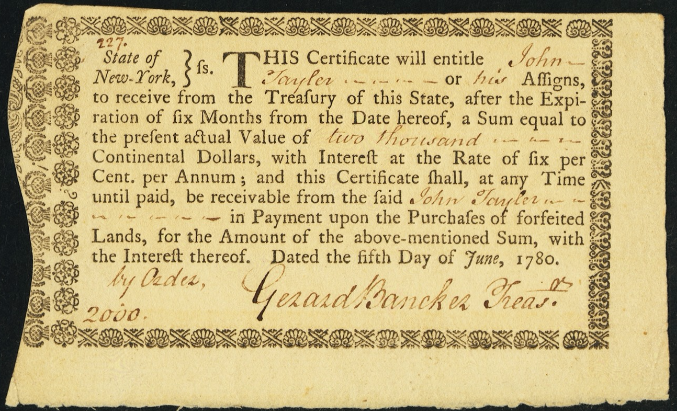
New-York 6% Six Month Loan Certificate
And here are links to definitions of the related terms "Chirograph" and "Indenture". -Editor
Chirograph
(https://en.wikipedia.org/wiki/Chirograph)
Indenture
(https://www.dictionary.com/browse/indentured)
To read the earlier E-Sylum articles, see:
BRITISH MUSEUM ACQUIRES BANKSY £10 NOTE
(https://www.coinbooks.org/v22/esylum_v22n05a33.html)
IN LETTERS WE TRUST: BANKNOTE TYPOGRAPHY
(https://www.coinbooks.org/v22/esylum_v22n08a15.html)
NEWMAN HISTORIC AMERICAN FISCAL PAPER : Lot 89390: New-York 6% Six Month Loan Certificate
(https://www.coinbooks.org/v20/esylum_v20n17a24.html)

LOOSE CHANGE: APRIL 7, 2019
Here are some additional items I came across in the media this week that may be of interest. -Editor
The Piacentile/Sheiner Fake 1964 Cent Error
Over on the CoinTalk discussion board Saturday, someone posted an interesting fake error coin I hadn't seen or heard of before. The 1964 Lincoln Cent appears to be double struck on the obverse side. According to the post, the pair marketing them claimed they had been found in sealed mint bags, and they even "staged a public demonstration at a NY hotel where they opened 'sealed' Mint bags and 'found' a few more identical errors!" -Editor


"After being tipped off to the U.S. Secret Service, the two wound up charged with various federal crimes and each got sentenced to 3 months in prison and 2 years probation. Featured here is one of those infamous cents they were charged with altering, which I acquired just yesterday. Though many detest altered and counterfeit coins, it can't be ignored that it did become a part of numismatic history. Although not as widely known as the Henning Nickel (which was counterfeit and wasn't made to scam collectors), the Piacentile/Sheiner cent is similar in that there was a key diagnostic blunder."
A Newman Numismatic Portal search found hits on a number of Coin World, Coins Magazine, Numismatic Scrapbook and Numismatist articles about the affair in the 1965-1970 timeframe. -Editor
To view the Newman Portal search results, see:
https://nnp.wustl.edu/library/searchwithterms?searchterm=Piacentile
To read the complete article, see:
I Acquired a Very Famous Counterfeit (Cited from:
(https://www.cointalk.com/threads/i-acquired-a-very-famous-counterfeit.336525/)
Man Paid for Pizza with Counterfeit Dough
It's not "Headless Body Found in Topless Bar" quality, but this headline deserves special mention: "Man paid for pizza with counterfeit dough." -Editor
Warwick police are looking for a man they say paid for a pizza with a phony $100 bill.
According to a post on the department's Facebook page, the man walked into Pizza King on Post Road Tuesday, ordered a pizza and paid using the counterfeit money.
Police said the man never returned to pick up his pizza.
Nothing makes me sadder than an orphaned pizza... -Editor
To read the complete article, see:
Man paid for pizza with counterfeit dough
(https://www.wpri.com/news/local-news/west-bay/police-man-paid-for-pizza-with-counterfeit-dough/1902757572)
MINT WEB SITE OUTAGE LEADS TO FREAK DEATH
Last week's issue came out a day before April Fool's Day. Under the subject line of "SOME of us wait until the proper day to publish these ...", Ken Barr offered the following, noting: "WOW, what a shame! A dedicated collector loses her life due to a dropped Internet connection ... This was just posted in the news.announce.strange-events newsgroup a few minutes ago." -Editor
BUGTUSSLE TRIBUNE, Bugtussle, Texas, April 1, 2019 (API)
by Noomie Nooze
Police are investigating the unusual death of Bugtussle resident Penny Doller, 57, who passed away earlier today while trying to complete an order on-line.
According to her husband, Zylber Doller, 59, his wife was excited about ordering the new Apollo 11 collector quarter fork being issued by the United States Mint starting at noon Eastern time today. "She got up early," Zylber told this reporter, "made herself a hearty breakfast, with several cups of coffee, and went on-line to get ready to order her special quarter fork. She had all the previous collector forks, from Apollo 1 through Apollo 10, mounted in a collector case next to her computer. The case had slots for the remaining forks, Apollo 11 through Apollo 17, which were to be issued over the next few years. She enjoyed all the Apollo missions, but claimed to be especially enamored of Apollo 11, since she said she dated Neil Armstrong in high school. He graduated high school in 1947, though, and she wasn't born until 1962, so we knew she wuz pulling our leg."
But a problem occurred, shortly before the ordering period started, Zylber related. "She was logged into the Mint website, verified that her credit card information and shipping address were current, and was continually hitting the Refresh button, waiting for the website to change from Not Yet Available to Ready For Ordering. At about two seconds before the hour, I heard a tremendous screech coming from the computer room, and rushed in to see what had happened. I suspected that a ne'er-do-well had climbed in the winder and was attacking her, based on the noise, but that was not the case."
Instead, Penny screamed that the Internet connection had dropped and her computer had gone off-line. "She desperately was pounding away on the keyboard, trying to get back on-line, and using some language that frankly caused me some embarrassment. I hadn't heard some of those words since our honeymoon." When she finally got back on-line, and onto the Mint's website again, all of the 1,776 Apollo 11 commemorative quarter forks being issued were totally sold out. "At that point, Penny went nuts," Zylber continued, "continued cussin' a blue streak, and grabbed one of the commemorative coin forks out of her cabinet. I think it was the Apollo VI one, but I'm not sure. In any event, she plunged it into her neck, and blood started spurting everywhere. I called 9-1-1, but by the time the ambulance arrived, she was gone. I really miss her." he concluded, wiping a tear from his eye.
Bugtussle Police homicide detective Quentin D. Bowers was reluctant to discuss the case. "We're investigating,", he assured the assembled media, "and will have a more detailed statement sometime in the future." He did admit that they had taken a commemorative quarter fork into evidence, and that it was indeed the Apollo VI example. The Bugtussle Coroner, Johns Hopkins Garrett, was more forthcoming later in the day, noting that the fork had perforated Mrs. Doller's carotid artery in a direct line, with every tine of the fork opening a hole in the artery. "Quite unusual", Garrett noted, "it's almost like she had medical training." Zylber, a retired surgeon, noted that he had "seen it before" in some cases of suicide he was familiar with.
Wichita County Power and Gas lineman M. Glen Cambel, who was working nearby when the incident occurred, stated that when he heard the scream, he looked over at the Doller house and thought he saw someone jiggling a wire at the junction box while looking at his watch. He thought that was an odd coincidence.
United States Mint Director Factotum B. Burrocrat, in a written statement, lamented the loss of such a dedicated collector of U. S. Mint products. He promised that an Apollo 11 commemorative coin fork would be delivered to the grieving widower before Mrs. Doller's funeral so that it could be placed in her coffin. "I'll just take one from the 1,770 pieces that the Homeboy Shopping Network ordered", he added, "They probably won't even notice."
Funeral details are pending, and may be delayed while Doller attends a week-long "grief camp" in the Bahamas with his secretary Bambi Vavoom, 23.
FEATURED WEB SITE: BRITISH BANKNOTE PICTURE LIBRARY
This week's Featured Web Site is part of the site of banknote dealer Pam West.
British Banknote Picture Library contains images collated by Pam over the years. The notes are for information only. Look on stock list for banknotes for sale. There are many rare banknotes pictured here, which we are sure you will enjoy

Dumbell's Banking Company, part issued note signed Shimmin
Click the links on the left of the page to navigate to images of English, Scottish, Isle of Man, Jersey and Irish banknotes, plus Postal Orders, Surrey provincials, Sketches and even Christmas notes. -Editor
http://britishnotes.co.uk/news_and_info/
picture_library/



